Nuestra conclusión
Pros
- Diseño de calidad premium
- Cómodas durante todo el día
- Ideales para caminar y correr
- Parte superior transpirable y duradera
- Estabilidad de 10
- Suela exterior mejorada
- Las mejores Cloudflyer hasta la fecha
- Cierre fantástico
Contras
- Caras para el rendimiento que ofrecen
- Mediasuela firme
- PESAN que flias
Veredicto de los usuarios
Comparativa
Las zapatillas de running más parecidas
+ + Añadir unas zapatillas | |||||
|---|---|---|---|---|---|
| Puntuación global | 83 Buenas | 89 Notables | 87 Notables | 85 Buenas | |
| Precio | 180 € | 150 € | 170 € | 160 € | |
| Pace | Correr a diario | Correr a diario | Correr a diario | Correr a diario | |
| Absorción de impactos | Baja | Moderada | Moderada | - | |
| Retorno de energía | Bajo | Alto | Alto | - | |
| Tracción | Moderada | Moderada | - | - | |
| Arch support | Estabilidad | Estabilidad | Estabilidad | Estabilidad | |
| Peso laboratorio Peso marca | 11.6 oz / 329g 11.3 oz / 320g | 9.8 oz / 279g 9.8 oz / 278g | 10.3 oz / 293g 10.5 oz / 297g | 12.5 oz / 353g 12.2 oz / 346g | |
| Drop laboratorio Drop marca | 7.9 mm 10.0 mm | 10.0 mm 10.0 mm | 9.8 mm 10.0 mm | 12.1 mm 12.0 mm | |
| Técnica de carrera | Medio/antepié | TalónMedio/antepié | TalónMedio/antepié | Talón | |
| Talla | Tallan bien | Tallan bien | Tallan bien | Tallan un poquito pequeño | |
| Rigidez de la mediasuela | Equilibrada | Equilibrada | Firme | Firme | |
| Diferencia de la rigidez de la mediasuela en frío | Normal | Pequeña | Pequeña | Pequeña | |
| Durabilidad de la parte delantera | Buena | Decente | Decente | Decente | |
| Durabilidad del acolchado del talón | Alta | Baja | Alta | Alta | |
| Durabilidad de la suela exterior | Buena | Decente | Mala | Buena | |
| Transpirabilidad | Media | Media | Baja | Media | |
| Anchura / ajuste | Estrecha | Media | Media | Media | |
| Anchura de la parte delantera | Media | Ancha | Ancha | Media | |
| Flexibilidad | Moderada | Flexible | Rígida | Rígida | |
| Rigidez torsional | Rígidas | Moderadas | Moderadas | Rígidas | |
| Rigidez del contrafuerte del talón | Moderado | Rígido | Moderado | Moderado | |
| Talón laboratorio Talón marca | 33.2 mm 31.0 mm | 33.1 mm 36.0 mm | 32.9 mm 31.0 mm | 36.5 mm 36.0 mm | |
| Antepié laboratorio Antepié marca | 25.3 mm 21.0 mm | 23.1 mm 26.0 mm | 23.1 mm 21.0 mm | 24.4 mm 24.0 mm | |
| Anchuras disponibles | Estándar | Estándar | Estándar | EstrechoEstándarAnchoExtra Ancho | |
| Orthotic friendly | ✓ | ✓ | ✓ | ✓ | |
| Estación | Todas las estaciones | Todas las estaciones | Todas las estaciones | Todas las estaciones | |
| Removable insole | ✓ | ✓ | ✓ | ✓ | |
| Clasificación | #248 33% inferior | #110 Top 30% | #168 Top 46% | #220 40% inferior | |
| Popularidad | #159 Top 43% | #258 30% inferior | #349 6% inferior | #187 49% inferior |
Quién debería comprárselas
Después de hacerles pruebas y pruebas a las On Cloudflyer 5 tanto dentro como fuera de nuestro laboratorio, hemos confirmado que son ideales para:
- Los corredores que le dan prioridad a la comodidad y a una calidad de fabricación sólida.
- Los que tienen problemas de estabilidad y buscan un modelo duradero y bien diseñado para correr durante kilómetros sin problema y poder llevarlo puesto durante todo el día.
- Los fans de las Cloudflyer 4, ya que esta actualización no pierde su ADN y mejora casi todos los detalles, quitando el peso.
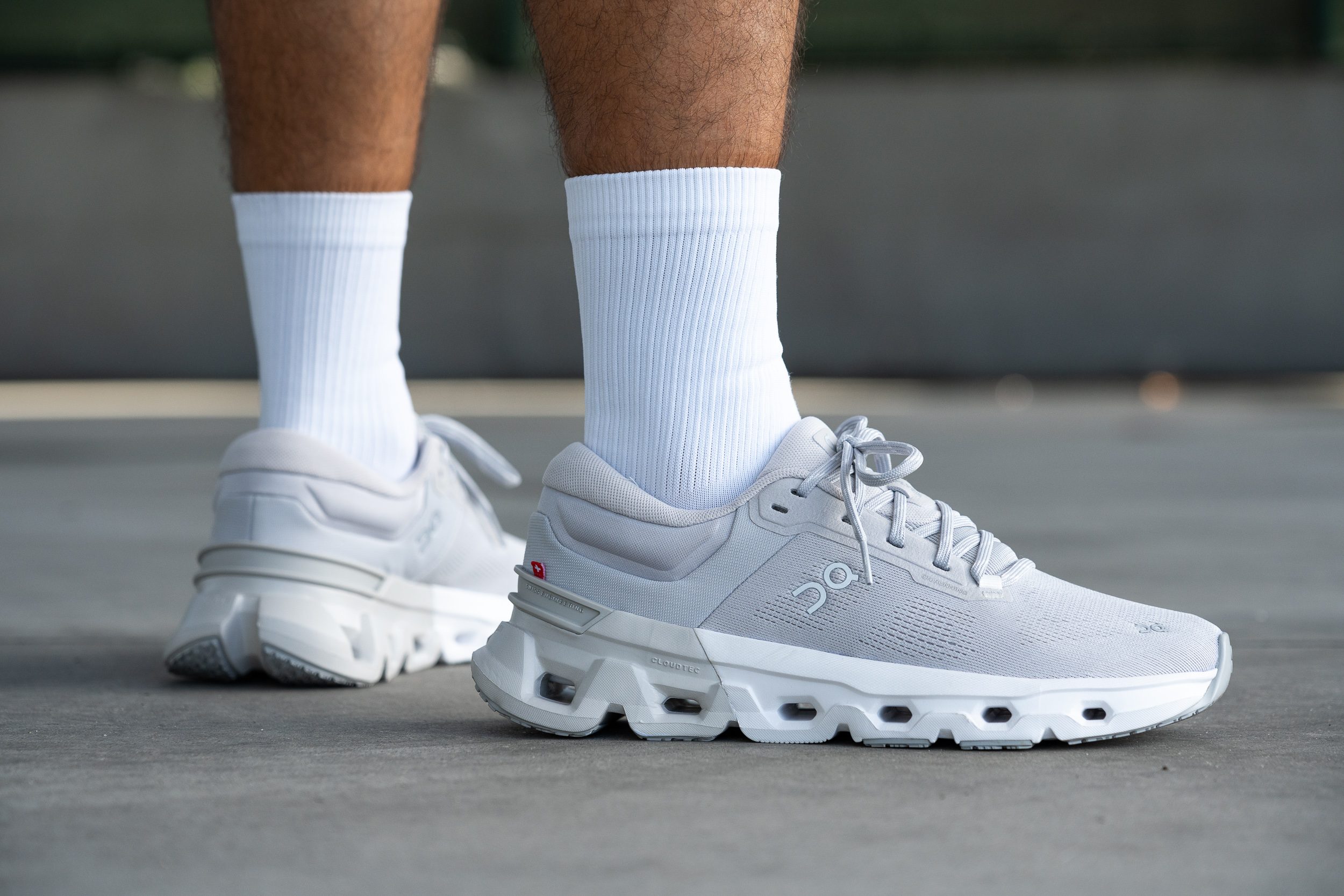
Quién NO debería comprárselas
En nuestra experiencia, las Cloudflyer 5 se quedan cortas para los corredores que priorizan el rendimiento. Aunque son cómodas hasta decir basta y tienen una estructura sólida, creemos que pesan demasiado, arruinando así la experiencia. Si el peso te parece un factor decisivo, te recomendamos que les eches un ojo a las ASICS GT 2000 13 o a las Altra Experience Form, que ofrecen un equilibrio mejor.
También creemos que su firme mediasuela Helion no conseguirá llamar la atención de muchos corredores. Aunque proporciona una estabilidad increíble, sacrifica demasiado la suavidad, lo que hace que la pisada ni tenga rebote ni sea divertida. Si estás buscando algo más blandito para tus pies, no te pierdas las ASICS Gel Kayano 31.
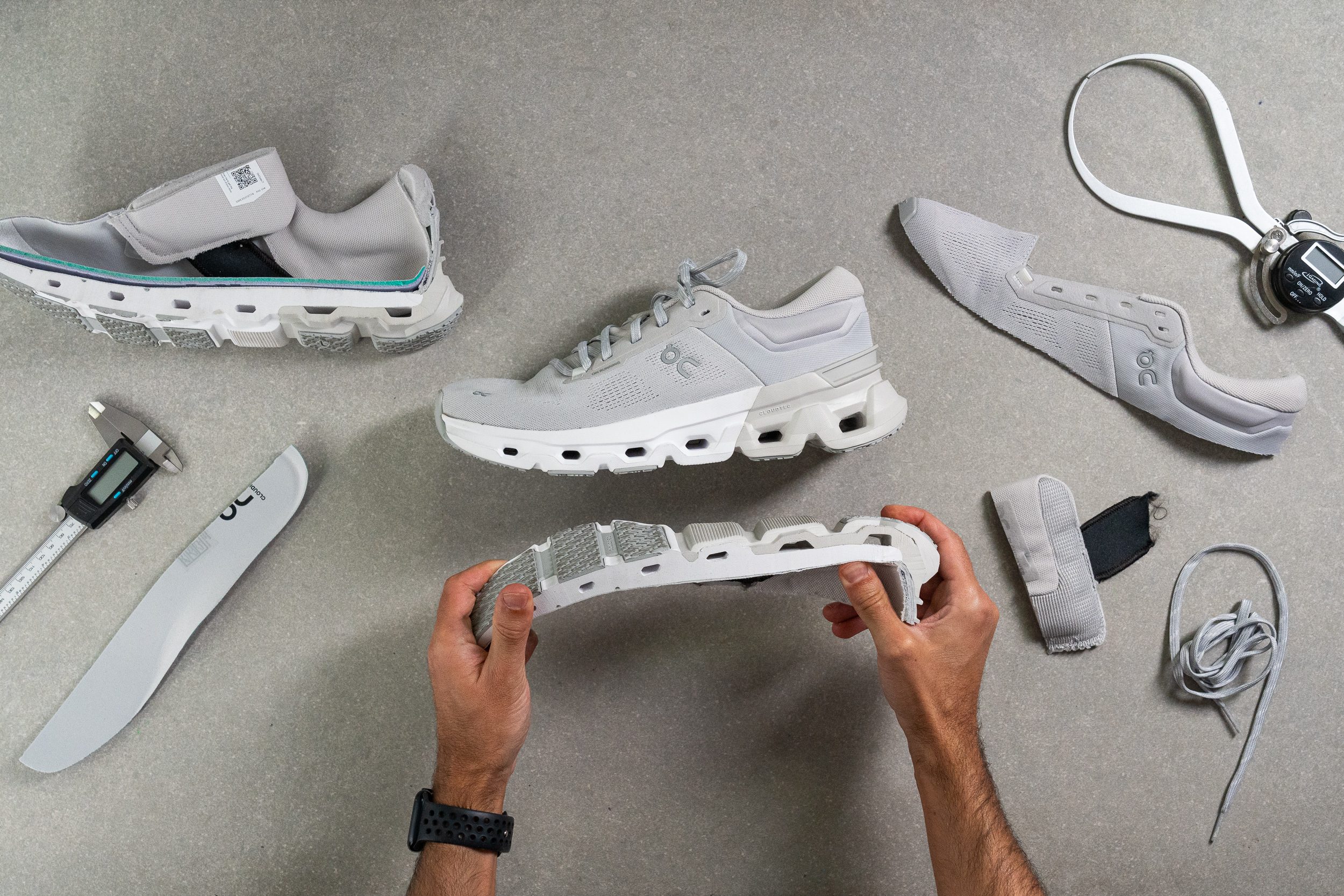
Amortiguación
Shock absorption
Las Cloudflyer 5 pueden parecer amortiguadísimas por fuera, pero nuestras pruebas de absorción de impactos le dieron un resultado sorprendentemente bajo: solo 108 SA. Por eso también analizamos las zapatillas en nuestro laboratorio, para que no te tengas que fiar solo de apariencias o suposuciones.
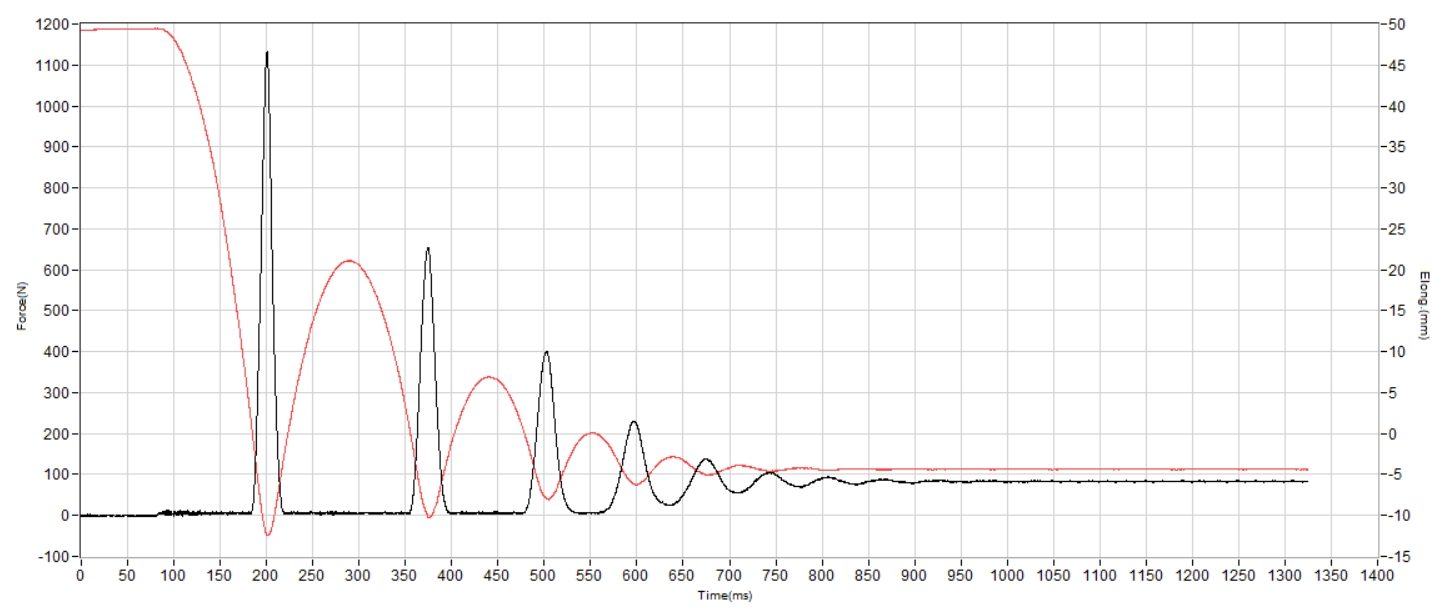
| Cloudflyer 5 | 108 SA |
| Media | 129 SA |
Energy return
En serio, On necesita lanzar una nueva espuma, porque la Helion no cumple con las expectativas.
Pedir tanto por un modelo que ofrece solo un 48,3 % de retorno de energía es una locura. Además, en los ejercicios de tempo se siente pesado, e incluso en los ritmos más bajos la pisada se siente plana.
| Cloudflyer 5 | 48.3% |
| Media | 58.5% |
Altura de la suela en la zona del talón
A primera vista, el peso de este modelo podría indicar que su diseño es maximalista pero, según nuestras mediciones, la altura de su suela se acerca más a la de unas zapatillas de running estándar, con solo 33,2 mm. Sinceramente, a nosotros nos parece positivo que no tengan una suela más alta, ya que eso habría hecho que las zapatillas pesasen incluso más..., ¡un desastre total!
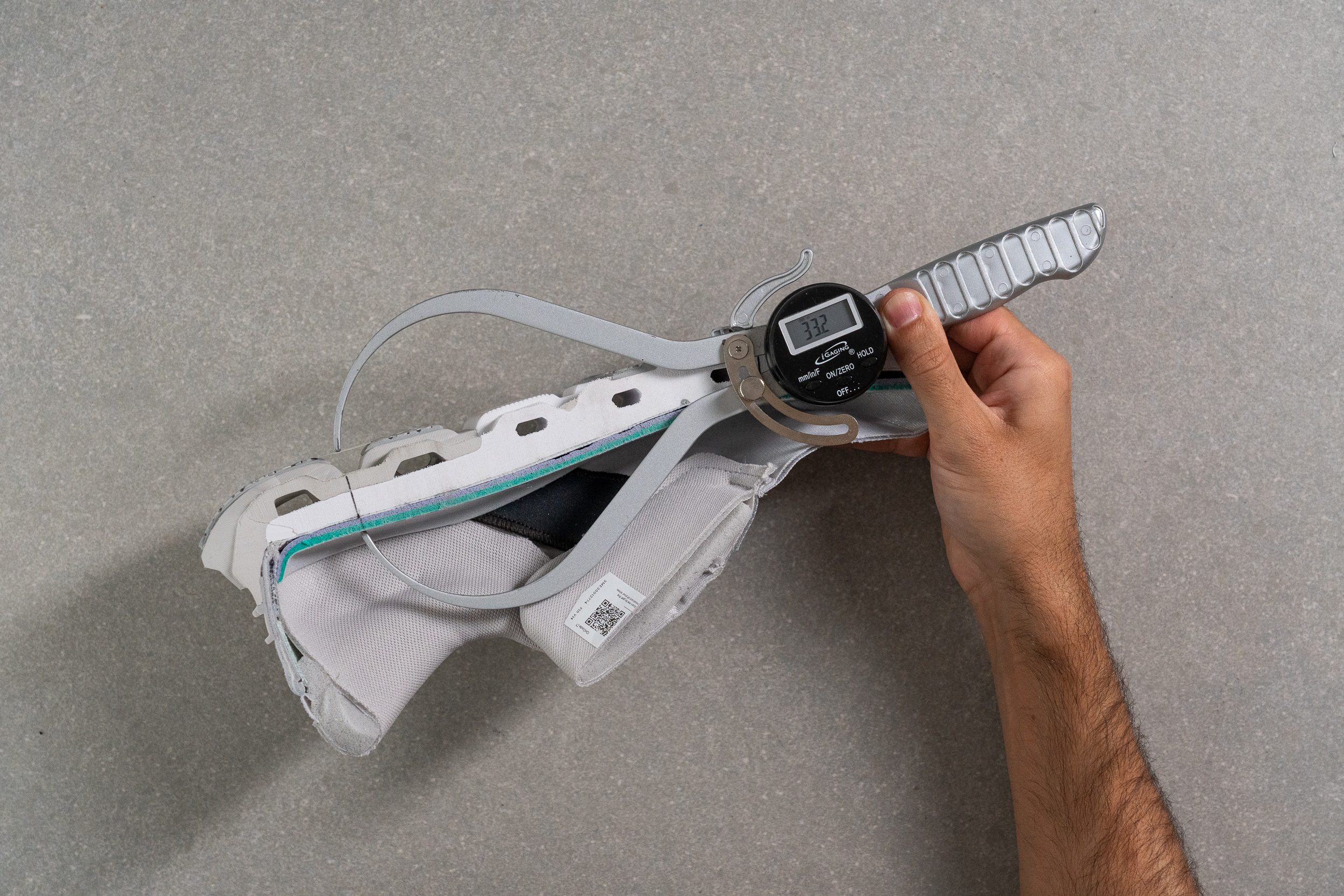
| Cloudflyer 5 | 33.2 mm |
| Media | 34.8 mm |
Altura de la suela en el antepié
El antepié es bastante más bajo que el talón, así que no te sientes tan separado del suelo; algo que se nota, sobre todo, a ritmos más rápidos. Lo confirmamos de primera mano, ya que nuestro calibre marcó 25,3 mm.
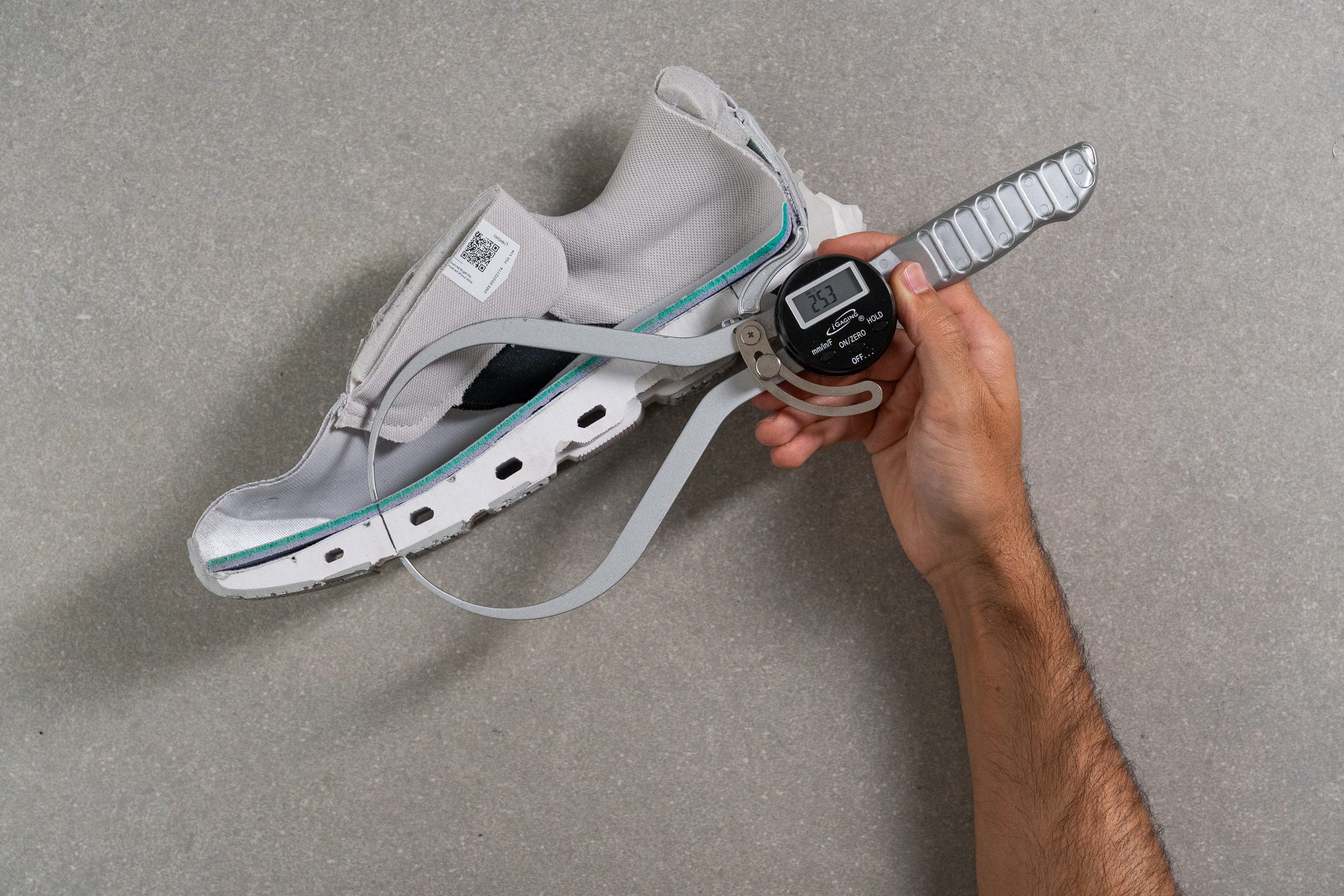
| Cloudflyer 5 | 25.3 mm |
| Media | 26.2 mm |
Drop
Por lo general, las zapatillas de On tienen un drop 6 mm, pero, según nuestra experiencia, la serie Cloudflyer es la excepción que confirma la regla para la marca suiza. En el modelo anterior, On decía que el drop era de 11,0 mm, y a nosotros nos dio 9,8 mm. En esta quinta edición, nos dio 7,9 mm, un poco por debajo de la cifra que da la marca, que son 10 mm.
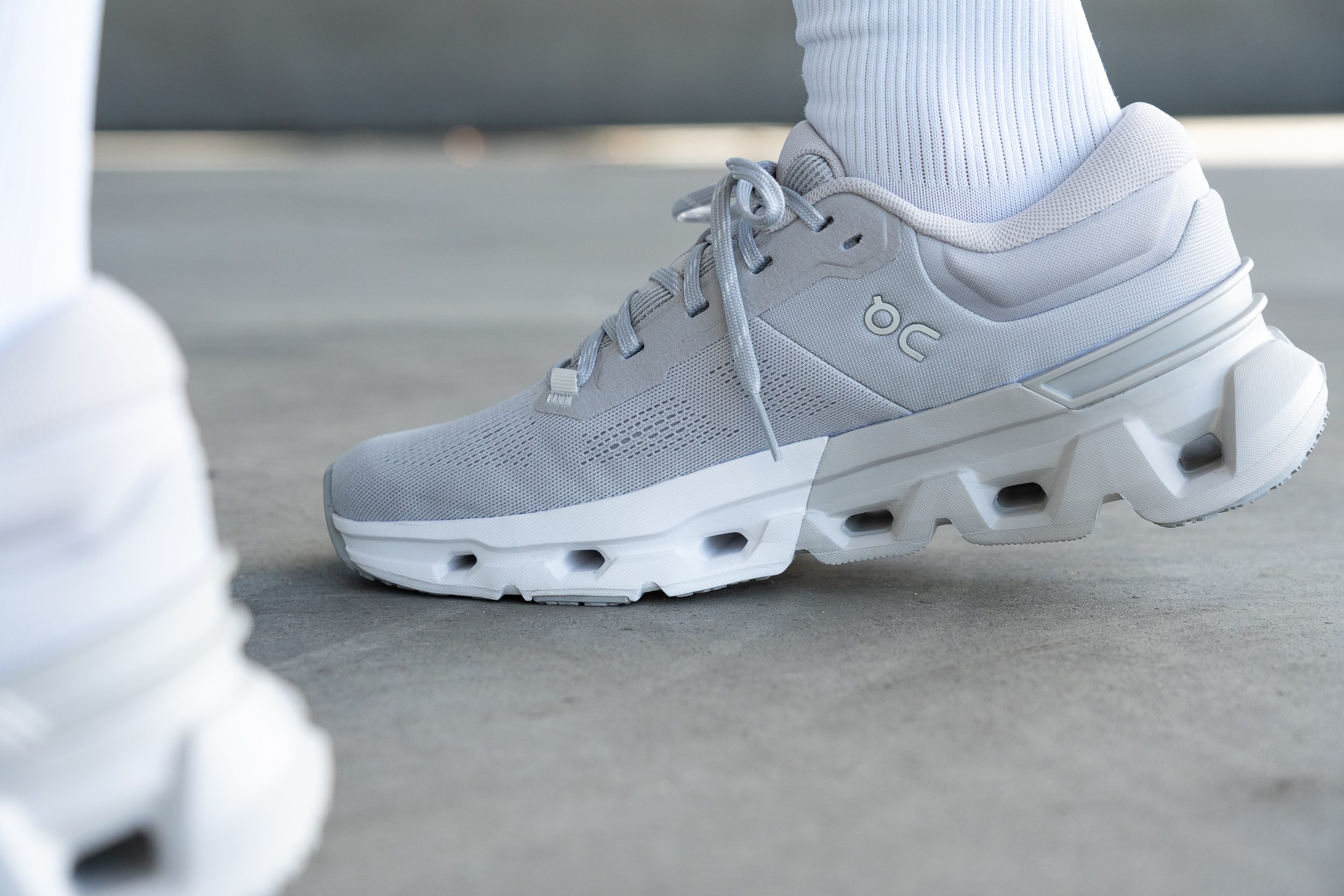
Vamos, que aunque la mayoría de las zapatillas de On suelen tener un drop medio, las Cloudflyer están diseñadas pensando más bien en los talonadores con su drop alto. Creemos que son una buena opción como zapatillas de estabilidad.
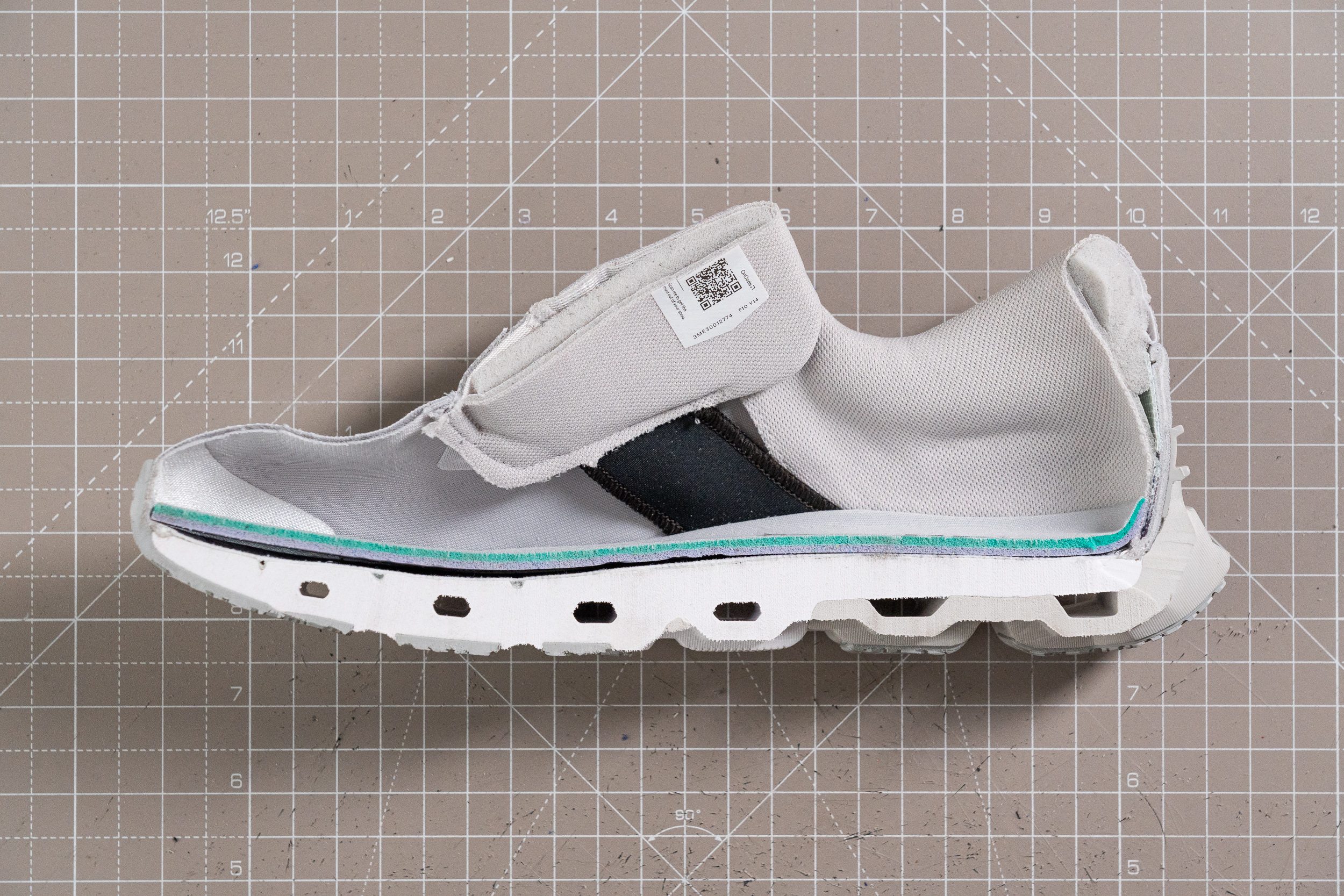
| Cloudflyer 5 | 7.9 mm |
| Media | 8.6 mm |
Suavidad de la mediasuela
Este es uno de los aspectos más interesantes de las Cloudflyer 5. On ha replicado la mediasuela Helion de doble densidad (EVA + Olefina) de sus predecesoras, lo que se traduce en una capa de espuma firme (28,0 HA) en el antepié y en el mediopié, acompañada por una capa secundaria incluso más firme en el talón para mejorar la estabilidad.
Aunque no nos gusta esa moda de hoy en día que dice que "cuanto más blandas, mejor" en el mundo de las zapatillas de running... tenemos que decir que esta mediasuela se siente demasiado firme bajo los pies. Incluso con la tecnología CloudTec, que facilita la compresión, nos preguntamos si los ingenieros de On se inspiraron en un ladrillo al diseñarla.
Eso sí, una mediasuela más dura que una piedra también tiene sus ventajas, como una buena sujeción. Además, a los que suelen estar incómodos con las mediasuelas más blandas seguro que les gusta. Pero no lo olvides: si estás buscando algo que sea blandito bajo los pies, este modelo no es para ti.

| Cloudflyer 5 | 28.0 HA |
| Media | 20.4 HA |
Suavidad de la espuma secundaria
Como hemos mencionado antes, las Cloudflyer 5 tienen un diseño de doble densidad con una placa de espuma Helion bastante más firme (37,0 HA) en el talón, diferenciada por su color gris.

Esta sección más densa se extiende más hacia el mediopié por la cara interna, ayudando a contener las fuerzas laterales y manteniendo el pie centrado. Vamos, ¡un detalle ideal para los pronadores!
Desde nuestro punto de vista, este diseño proporciona estabilidad. Sin embargo, también hace que la pisada sea bastante tosca, y creemos que solo los que realmente estén buscando un modelo firme y bajo estarán contentos con la sensación que proporcionan estas zapatillas.

| Cloudflyer 5 | 37.0 HA |
| Media | 22.7 HA |
Rocker
On ha decidido irse por un camino distinto al de modelos como las Cloudsurfer 7, elaborando una mediasuela plana, sin rocker, que prioriza la estabilidad. Esta elección de diseño hace que las zapatillas sean menos dinámicas, sobre todo para los talonadores.
Esto no es ni algo bueno ni algo malo, solo es un enfoque distinto del diseño típico de las zapatillas de running. A algunas personas les gustará más el perfil más plano de unas zapatillas de estabilidad, ya que te hacen sentirte más seguro, mientras que otras buscarán esa energía extra de las suelas que están un poco curvadas. ¿Qué grupo es el tuyo?

Tallaje y ajuste
Talla
Las On Cloudflyer 5 tallan bien (28 votos).
Width / Fit
Some of you may have guessed that with the Cloudflyer’s midsole now larger than ever, it might also offer a roomier fit. Well, not quite. While the toebox is slightly more spacious than before, we measured it at 98.2 mm at its widest—still mostly average.
The toebox also features a medium-to-low volume forefoot, which means that runners who naturally point the big toe upward may experience slight pressure in this area.
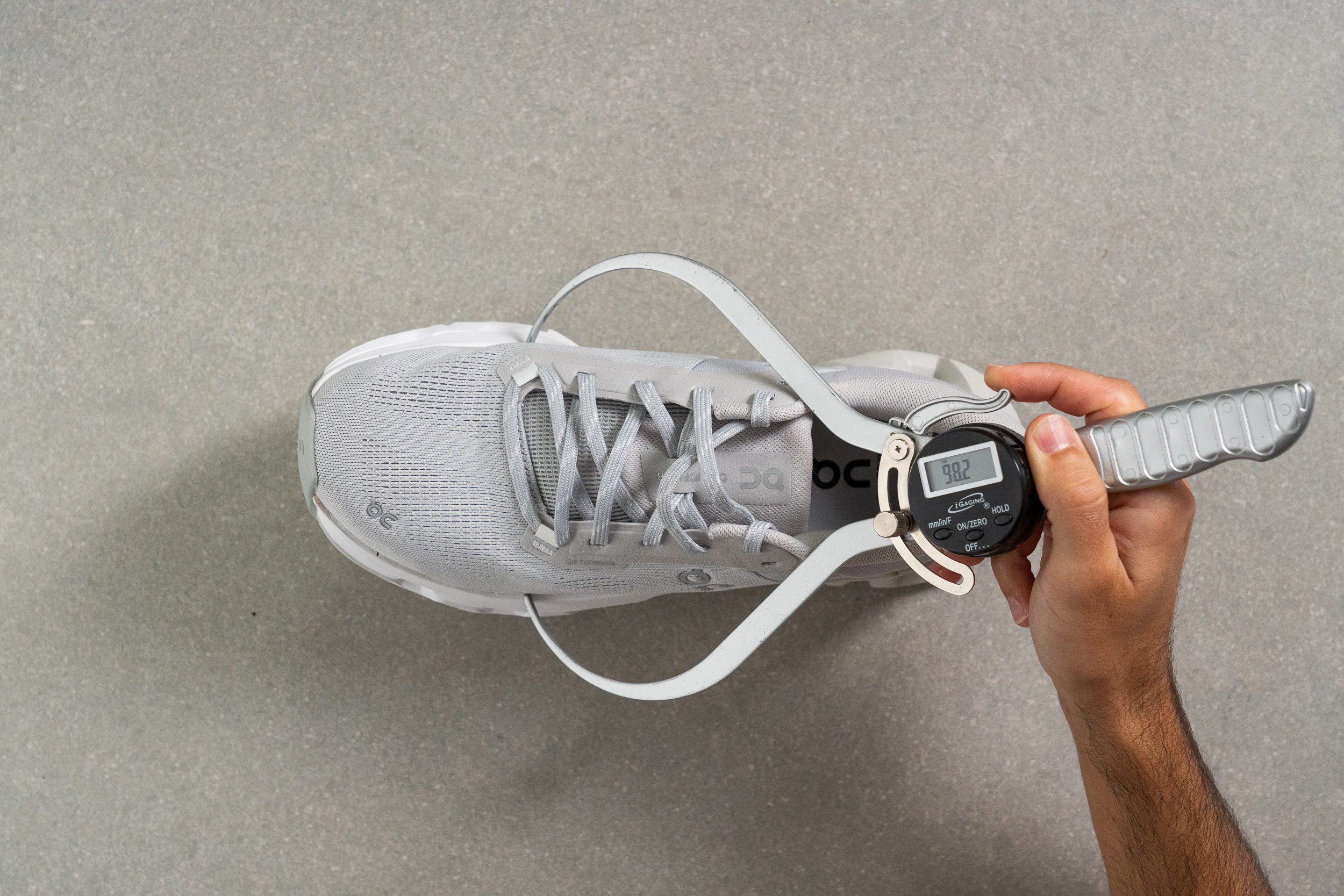
En esta prueba se utiliza una metodología antigua, así que no verás las zapatillas que hemos analizado últimamente en la tabla. Los resultados obtenidos con metodologías distintas no se pueden comparar.
| Cloudflyer 5 | 98.2 mm |
| Media | 98.5 mm |
Toebox width
We recorded a second width measurement in the big toe area at 78.4 mm, perfectly matching our findings in testing. If we had to define the fit of the Cloudflyer, we’d say that it's neither spacious nor snug, simply comfortably average.
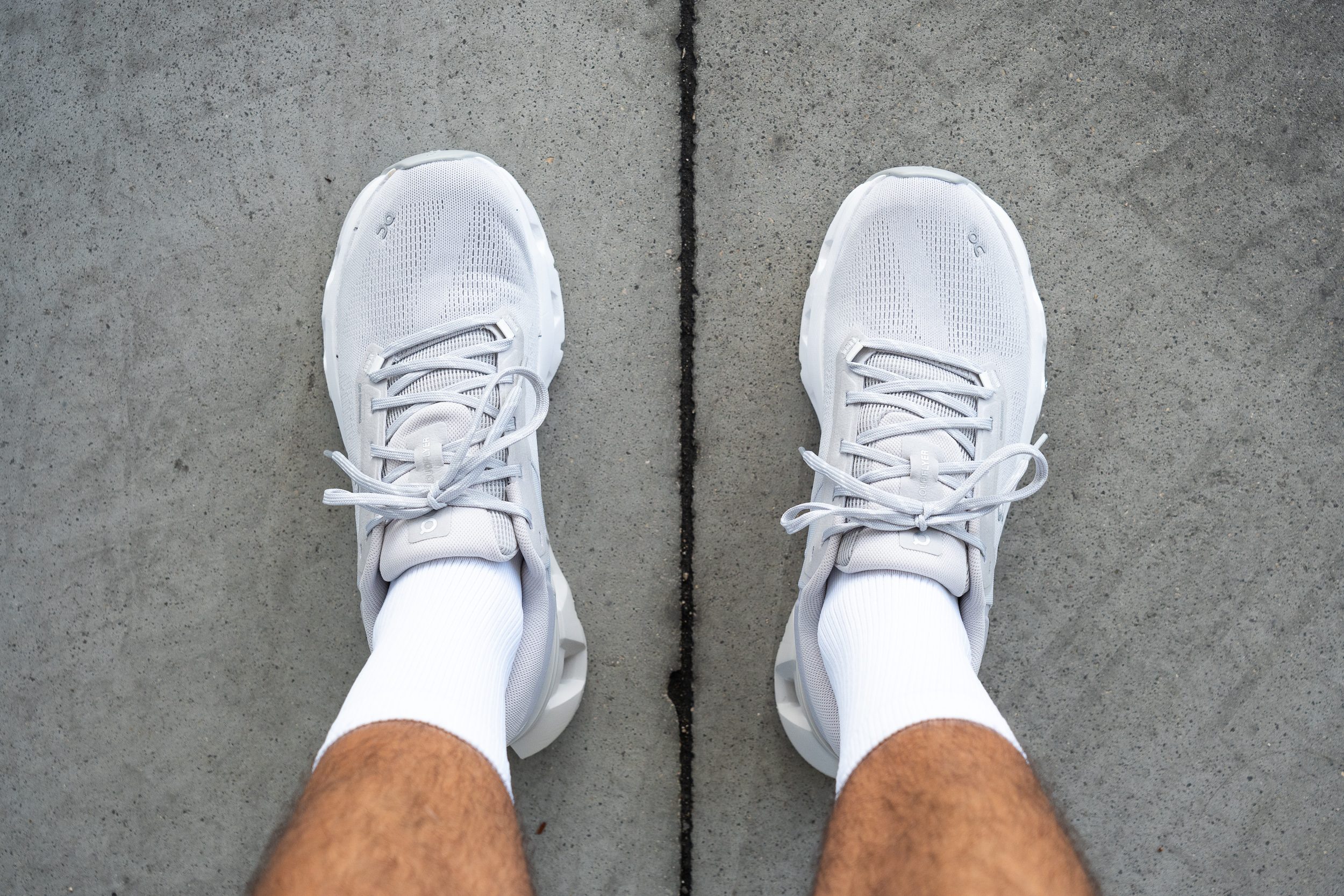
Thanks to this width, the Cloudflyer 5 gains a boost in stability—the combination of a standard-width toebox and a broader landing base offers naturally enhanced support.
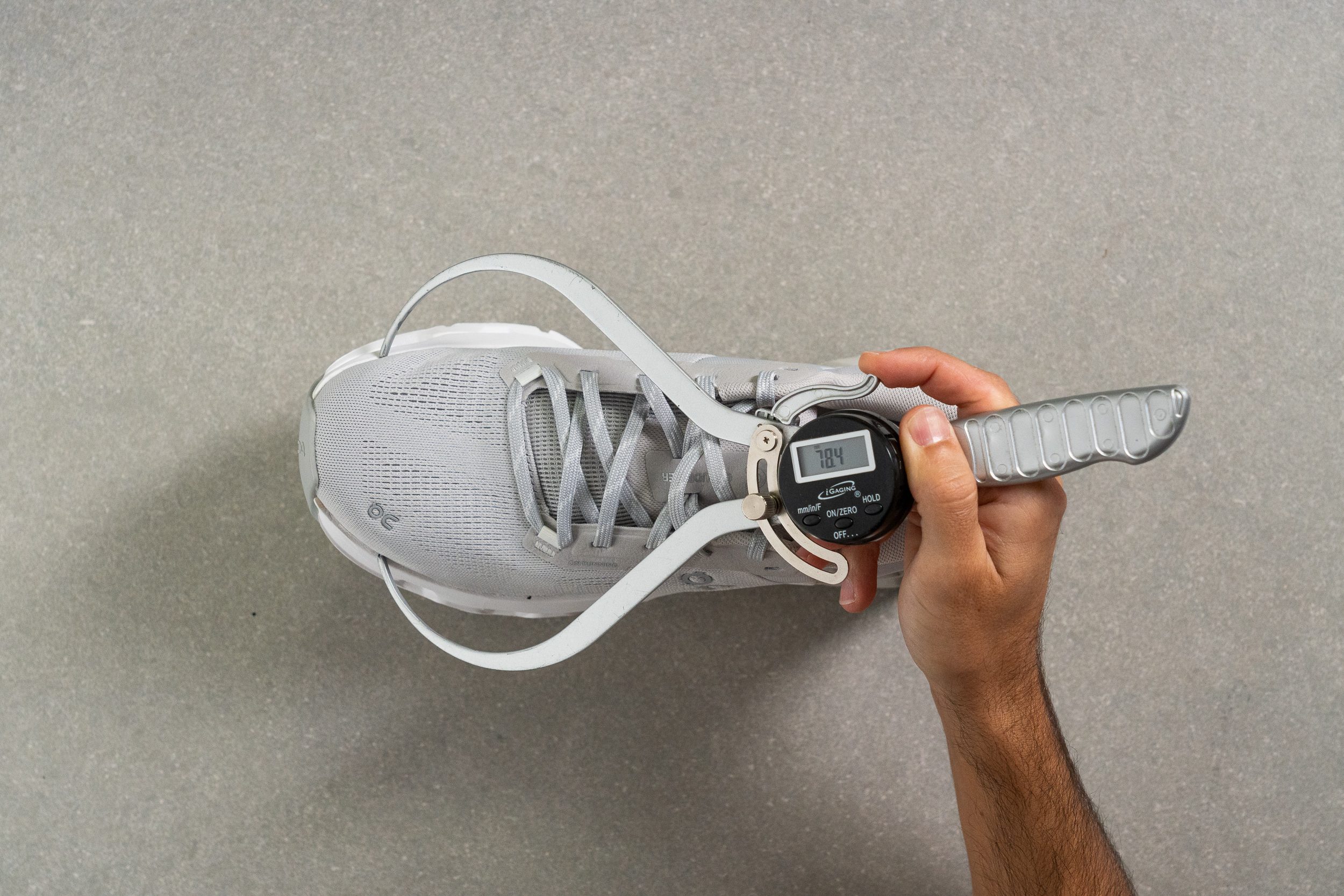
En esta prueba se utiliza una metodología antigua, así que no verás las zapatillas que hemos analizado últimamente en la tabla. Los resultados obtenidos con metodologías distintas no se pueden comparar.
| Cloudflyer 5 | 78.4 mm |
| Media | 78.4 mm |
Tracción / Agarre
Traction test
Analizamos la tracción de las Cloudflyer 5 sobre hormigón mojado y se llevaron un 0,41. Creemos que es suficiente para proporcionar un buen agarre incluso si llueve.
| Cloudflyer 5 | 0.41 |
| Media | 0.48 |
Diseño de la suela exterior
Nos hemos dado cuenta de que la suela exterior es muy parecida a la de las On Cloudmonster 2. Tiene grandes parches de caucho que cubren los laterales del talón y del antepié, mejorando la durabilidad, mientras que el corte del centro mejora la flexibilidad, aunque a veces se le puede quedar alguna piedrecilla atrancada.
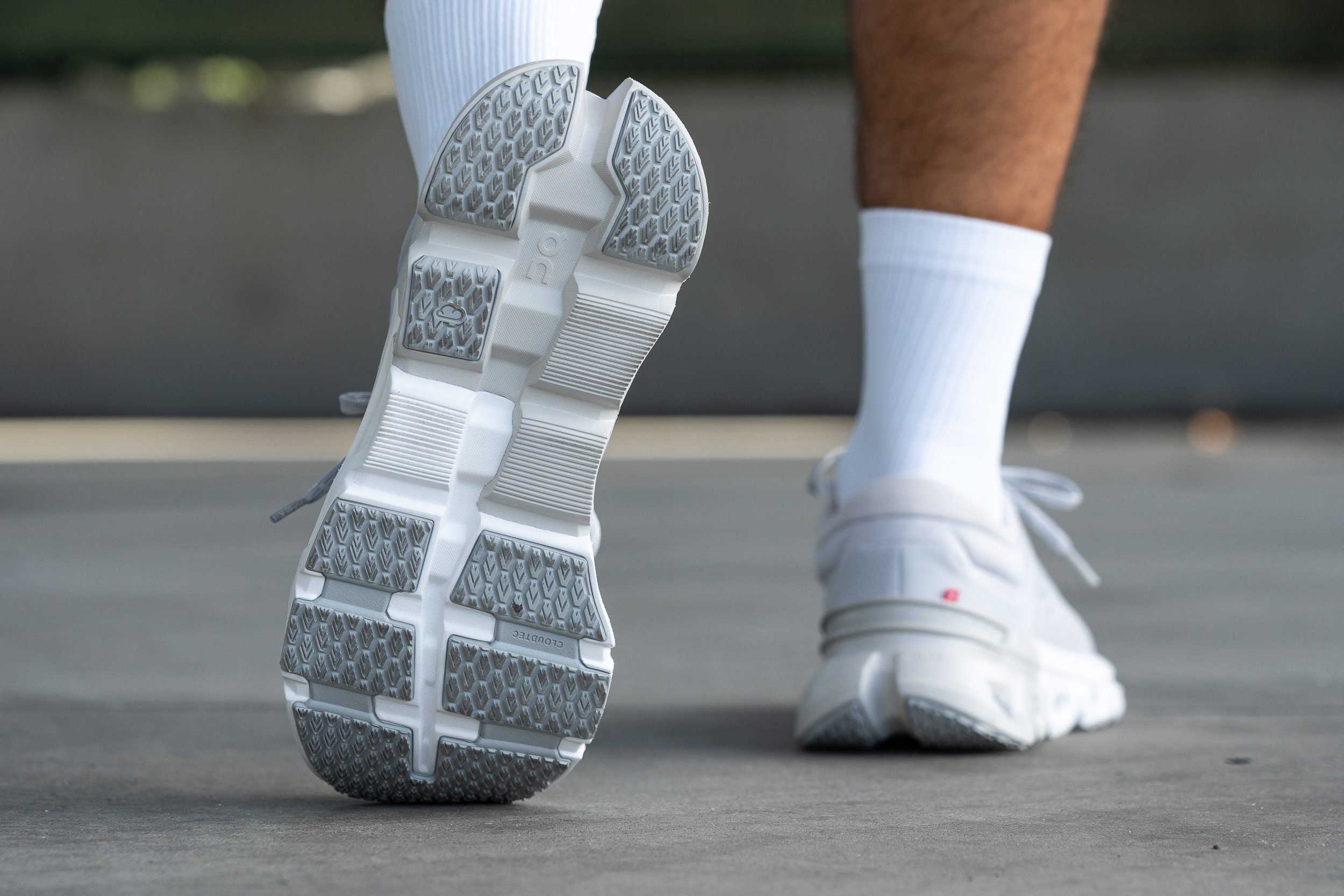
Flexibilidad / Rigidez
La firmeza de la mediasuela dificulta un poco que estas zapatillas sean muy flexibles, pero On lo solucionó poniéndoles cortes tanto en la mediasuela como en la suela. En nuestra prueba de flexión a 30 grados, necesitaron 14,8 N para doblarse, confirmando así su versatilidad. Vamos, que te puedes poner este pa para hacer tus recados del día a día (además de para correr, claro).
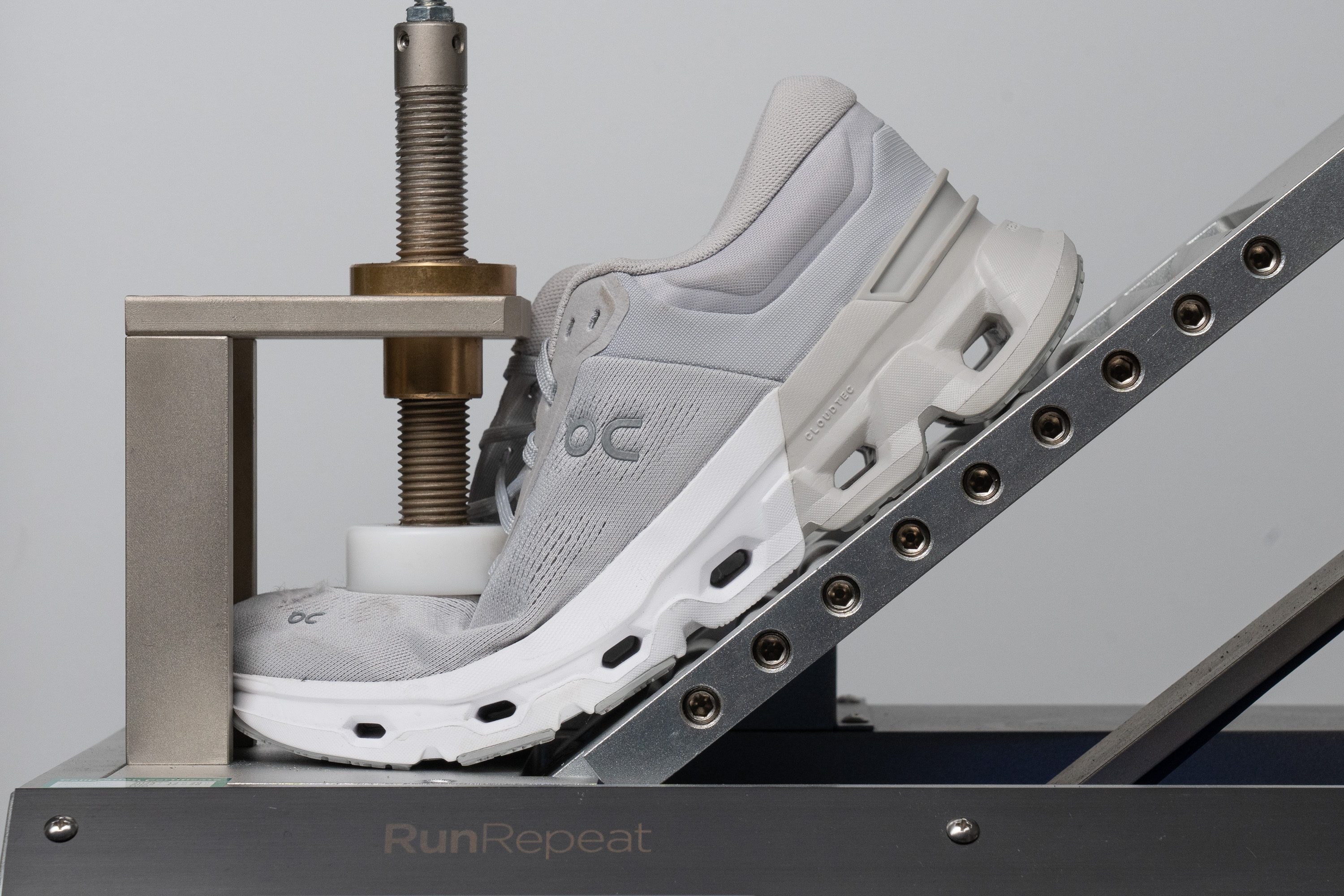
| Cloudflyer 5 | 14.8N |
| Media | 15.3N |
Peso
Si tuviéramos que comparar las Cloudflyer 5 con un coche, serían un Audi A8: muy estables, comodísimas, y... ¡pesadas hasta decir basta!
En nuestra opinión, este es uno de los dos principales inconvenientes de las Cloudflyer 5. Aunque su parte superior es mullida y suela podría haber sido un tanque en otra vida, creemos que estas zapatillas deberían rondar los 280-285 g, pero resulta que van hasta los 329 g.

Por lo tanto, si estás buscando un modelo ligero como las ASICS Novablast 4 o las Nike Pegasus Plus, es probable que este no te termine de convencer. Pero si priorizas la comodidad y la durabilidad, dejando un poco más de lado el peso, entonces es probable que las Cloudflyer 5 te encanten.
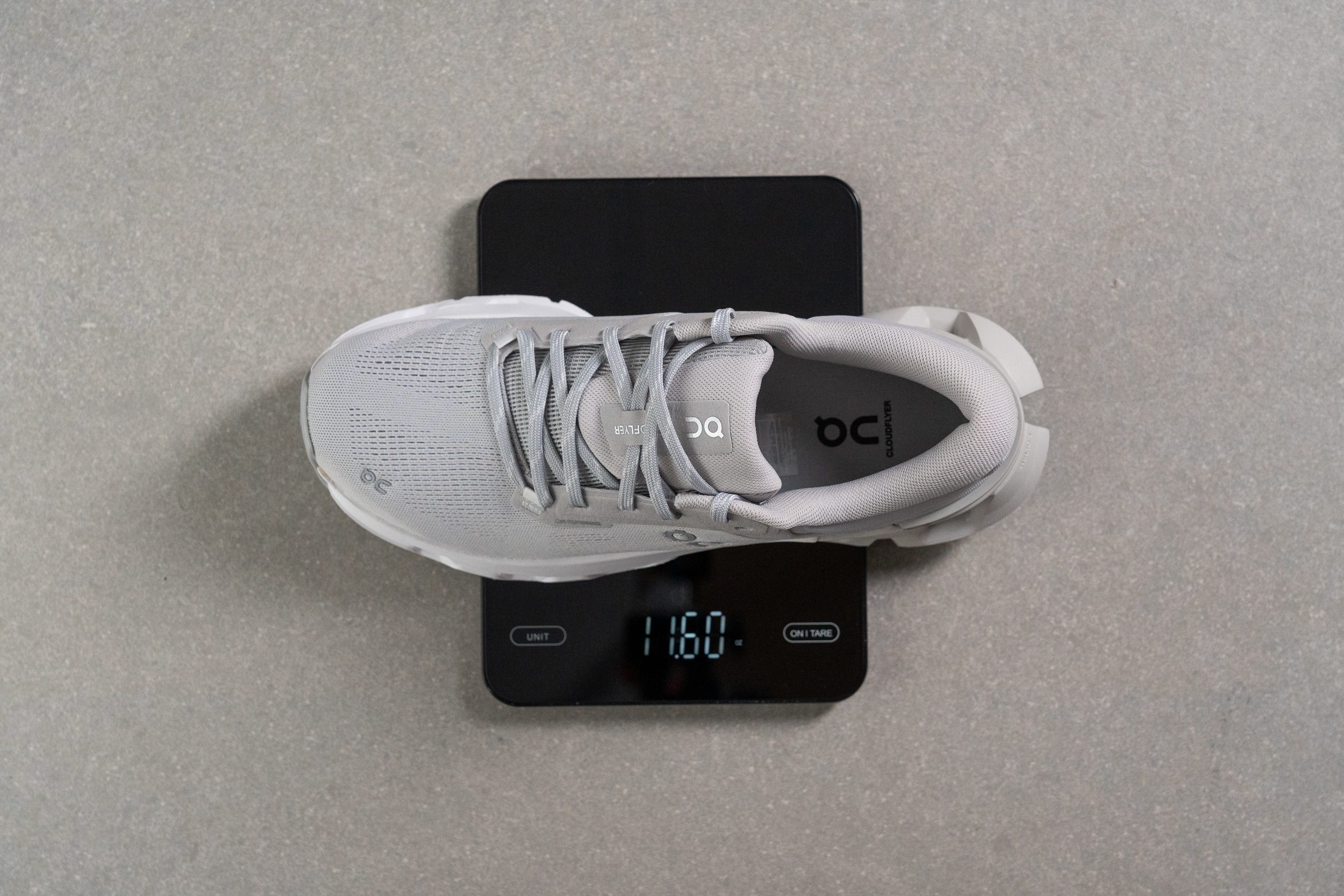
| Cloudflyer 5 | 11.6 oz (329g) |
| Media | 9.3 oz (264g) |
Transpirabilidad
No te vamos a engañar, al principio no confiábamos mucho en que las Cloudflyer 5 dejasen que el aire entrase y saliese de ellas fácilmente, ya que su parte superior nos parecía menos transpirable que la de las Cloudflyer 4. ¡Pero estábamos equivocados!
Aunque ahora el material es de más calidad y, a su vez, también más mullido, esta quinta versión deja que el aire salga fácilmente, así que se ha llevado un 4/5 en transpirabilidad. Justo la misma nota que sus predecesoras, pero siendo más cómoda.
Gracias a nuestra luz, pudimos descubrir cómo On consiguió este resultado tan positivo. Los agujeritos para que el aire entre y salga están estratégicamente colocados en la parte delantera y en la zona del mediopié, con la única excepción de la lengüeta reforzada. Pero este último detalle no afecta a los niveles de transpirabilidad, ya que se encuentra más atrás.
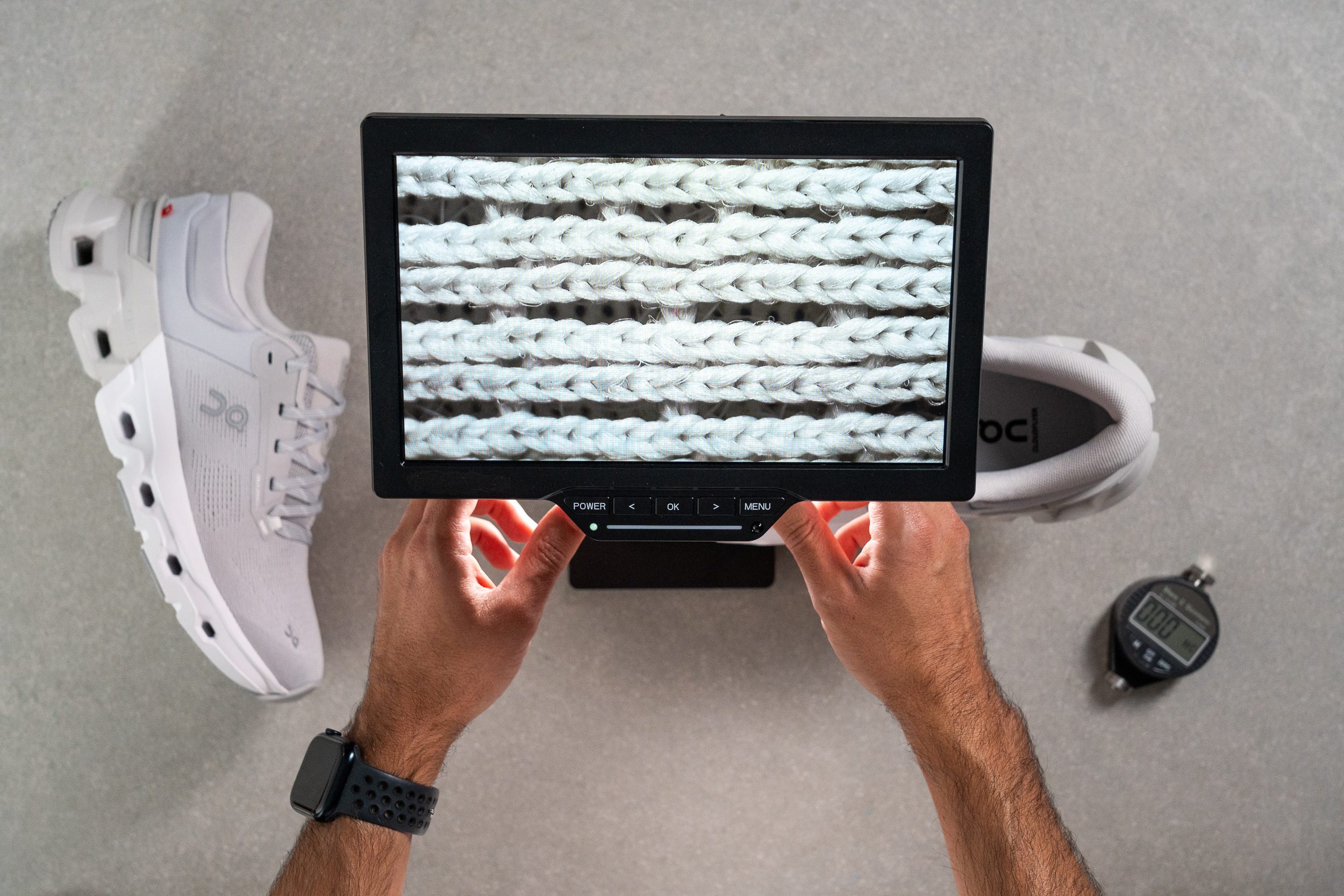
Para entender mejor el refinado diseño de esta parte superior, hemos analizado las Cloudflyer 5 bajo nuestro microscopio. Vimos que tienen una malla de ingeniería de varias capas con un patrón entrecruzado que, por lo menos en cuanto a transpirabilidad, ofrece un rendimiento fantástico.
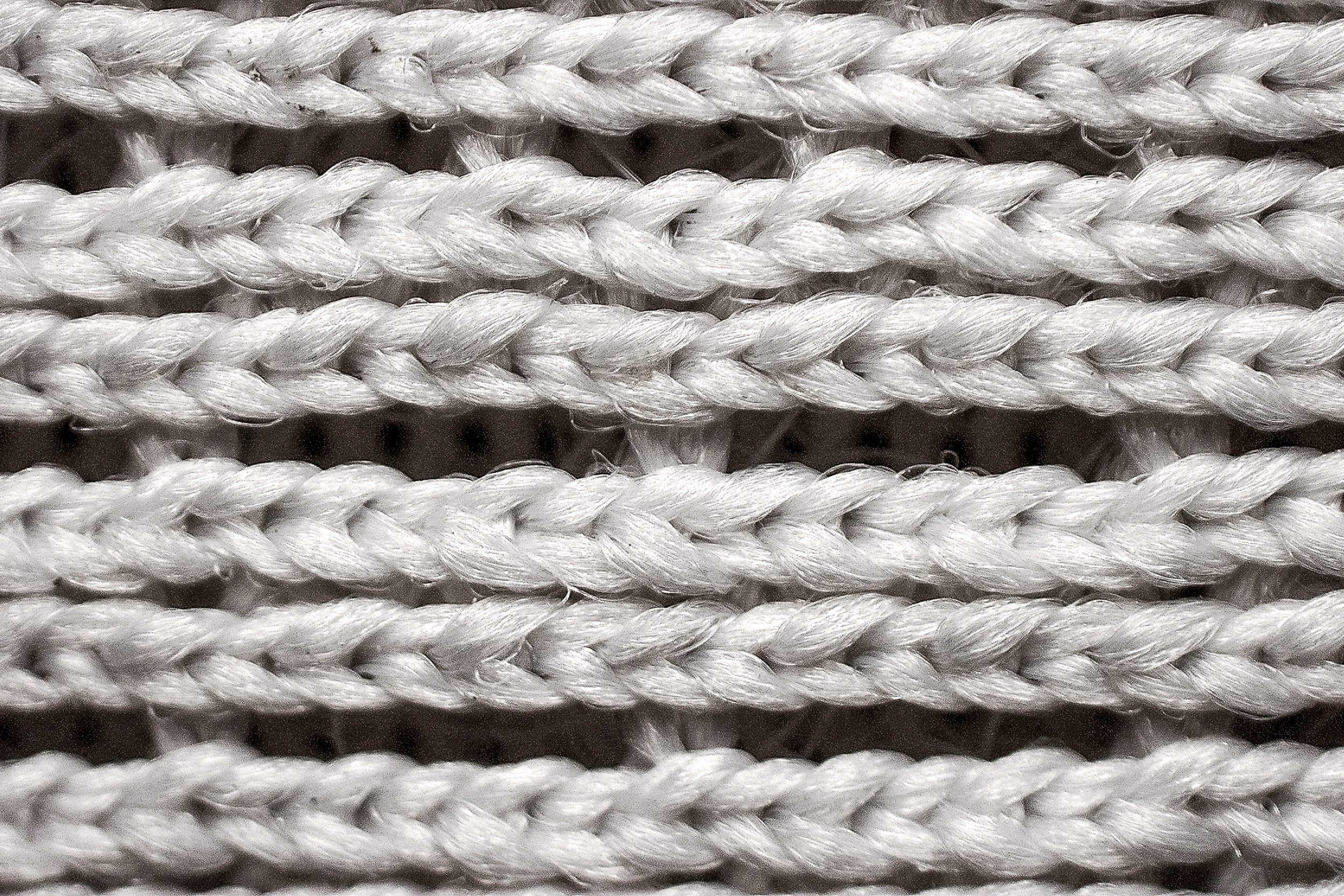
La parte superior es increíble, ya que está muy acolchada en las zonas que tienen que ser más cómodas, como el talón y la lengüeta, pero es más fina en las partes que requieren un mejor flujo de aire.
Creemos que el riesgo de que te rocen o te parezcan incómodas es prácticamente cero, así que nos parecen unas zapatillas perfectas para llevar durante todo el día. Es más, tienen una de las partes superior más finas que hemos visto en nuestro laboratorio, ¡una pasada!
| Cloudflyer 5 | 4 |
| Media | 3.7 |
Estabilidad
Prueba de estabilidad lateral
Las dos características más destacadas de este modelo son su parte superior mullida y su fantástica estabilidad. Como ya hemos hablado de la primera, ahora vamos a centrarnos en la segunda.
Las Cloudflyer 5 mejoran el nivel de sujeción de sus predecesoras, utilizando una inteligente mezcla de elementos que mejoran la estabilidad, como el diseño de doble espuma, un clip de plástico en el talón en la zona del calcáneo, y una base más ancha en el talón y el antepié. Todas estas características trabajan en equipo para mantener el pie centrado y bien sujeto.
Rigidez torsional
Descubrimos que las Cloudflyer 5 son muy rígidas a nivel torsional, como es de esperar de la mayoría de las zapatillas de estabilidad. Se llevaron un 4/5 en nuestra escala, y no consiguieron el 5 por los cortes de su suela exterior, que le dieron ese puntito de flexibilidad que les faltó.
| Cloudflyer 5 | 4 |
| Media | 3.5 |
Rigidez del contrafuerte del talón
En nuestra opinión, el contrafuerte del talón se centra en la comodidad, así que se ha llevado un 3/5 en nuestra escala, igual que el de sus predecesoras.
En lugar de optar por un diseño ultra rígido, típico de las zapatillas para pronadores, On prioriza la suavidad en este caso, confiando en un clip de plástico en la parte de abajo del talón para ofrecer estabilidad, y haciendo que la zona de alrededor del tendón de Aquiles no sea tan rígida. La verdad es que estamos muy contentos con esta elección, sobre todo cuando nos pusimos las CF5 durante muchas horas.
| Cloudflyer 5 | 3 |
| Media | 2.9 |
Anchura de la mediasuela - antepié
Uno de los elementos característicos de muchos modelos de On (las superzapatillas de entrenamiento Cloudmonster Hyper incluidas) es su mediasuela estrecha. Pero, en nuestra opinión, utilizar un diseño tan aerodinámico en unas zapatillas de estabilidad es un error.
Y la marca parece estar de acuerdo con nosotros. En las Cloudflyer 5, nos encontramos con un antepié muy ancho que, según nuestro calibre, alcanza los 119,0 mm, ofreciéndoles sujeción a todos los corredores que tengan problemas de pronación o supinación.
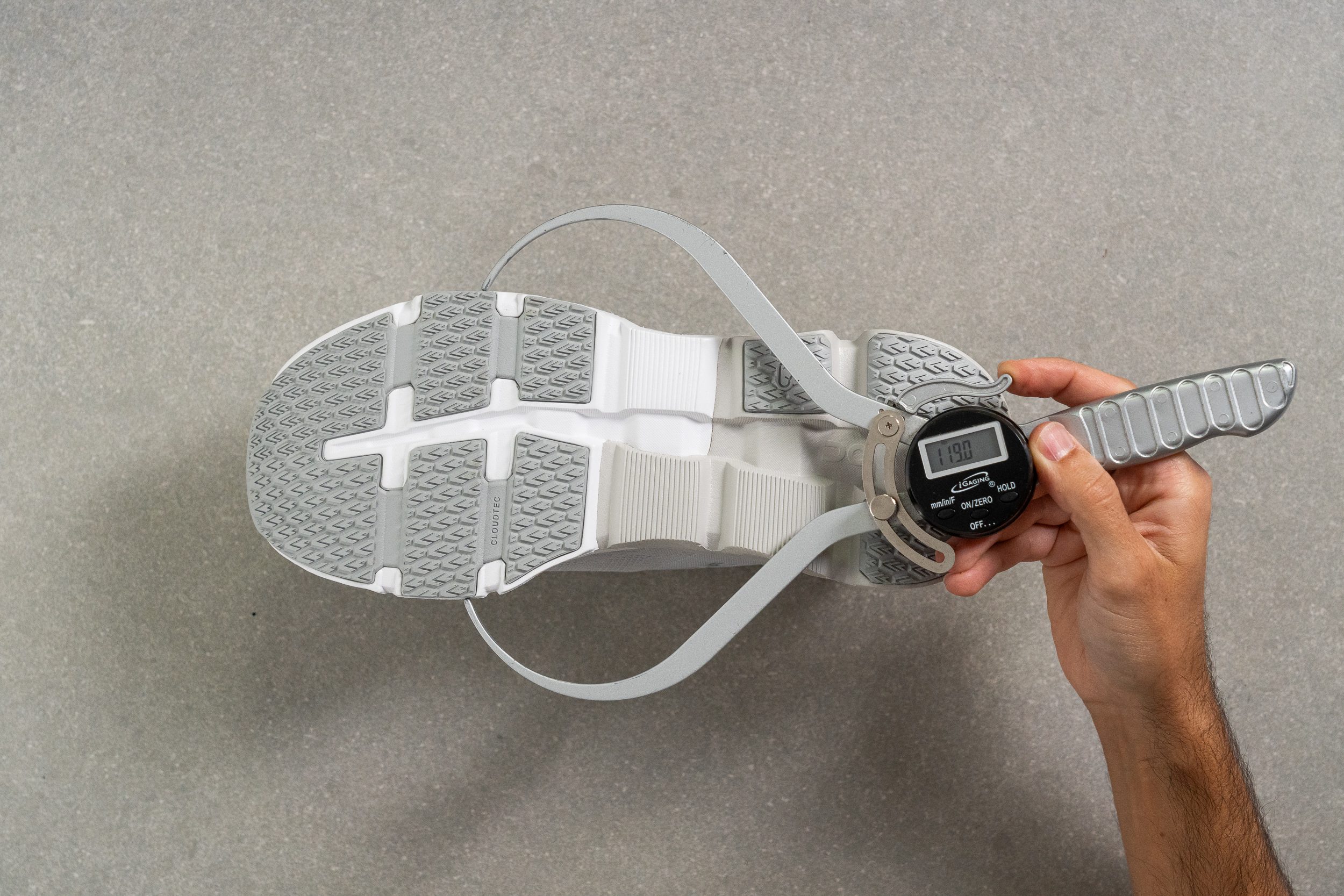
| Cloudflyer 5 | 119.0 mm |
| Media | 114.4 mm |
Anchura de la mediasuela - talón
En el talón es donde estas zapatillas destacan cuando hablamos de sujeción y estabilidad extra. Su mediasuela rediseñada mide ahora 100,1 mm más, una mejora significativa respecto a los 90,3 mm que vimos en la versión 4.
Esta anchura extra nos parece muy importante, ya que las zapatillas se han diseñado pensando en los talonadores. En nuestra opinión, las Cloudflyer 5 al fin consiguen cumplir con los requisitos que necesitan este tipo de corredores, que no estaban contentos con el modelo anterior incluso con su drop alto.
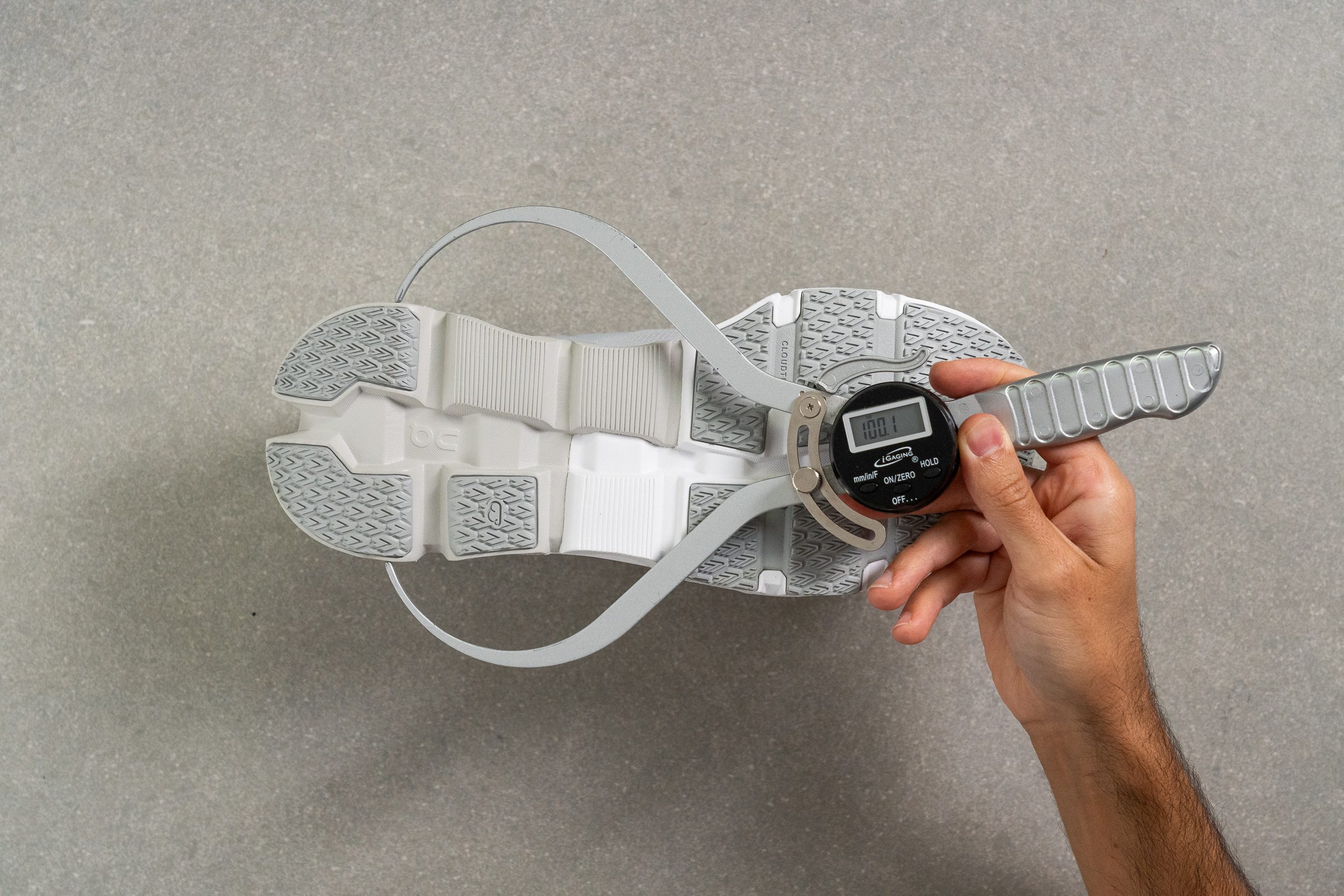
| Cloudflyer 5 | 100.1 mm |
| Media | 90.7 mm |
Durabilidad
Durabilidad de la parte delantera
Ya sabemos que son muy cómodas y transpirables, así que ahora nos toca averiguar si su diseño también es resistente, que es un problemilla muy común entre las zapatillas de running.
Nuestro Dremel no consiguió hacerle tanto daño al upper de malla de estas zapatillas, la verdad, así que les dimos a las CF5 un sólido 4/5 en durabilidad, que es una nota mucho mejor que la de sus predecesoras, que se fueron a casa con un 1/5 en esta misma prueba. La verdad es que estamos encantados con este resultado, ya que no hay muchos modelos con un diseño que consiga ser transpirable y resistir el desgaste a este nivel.
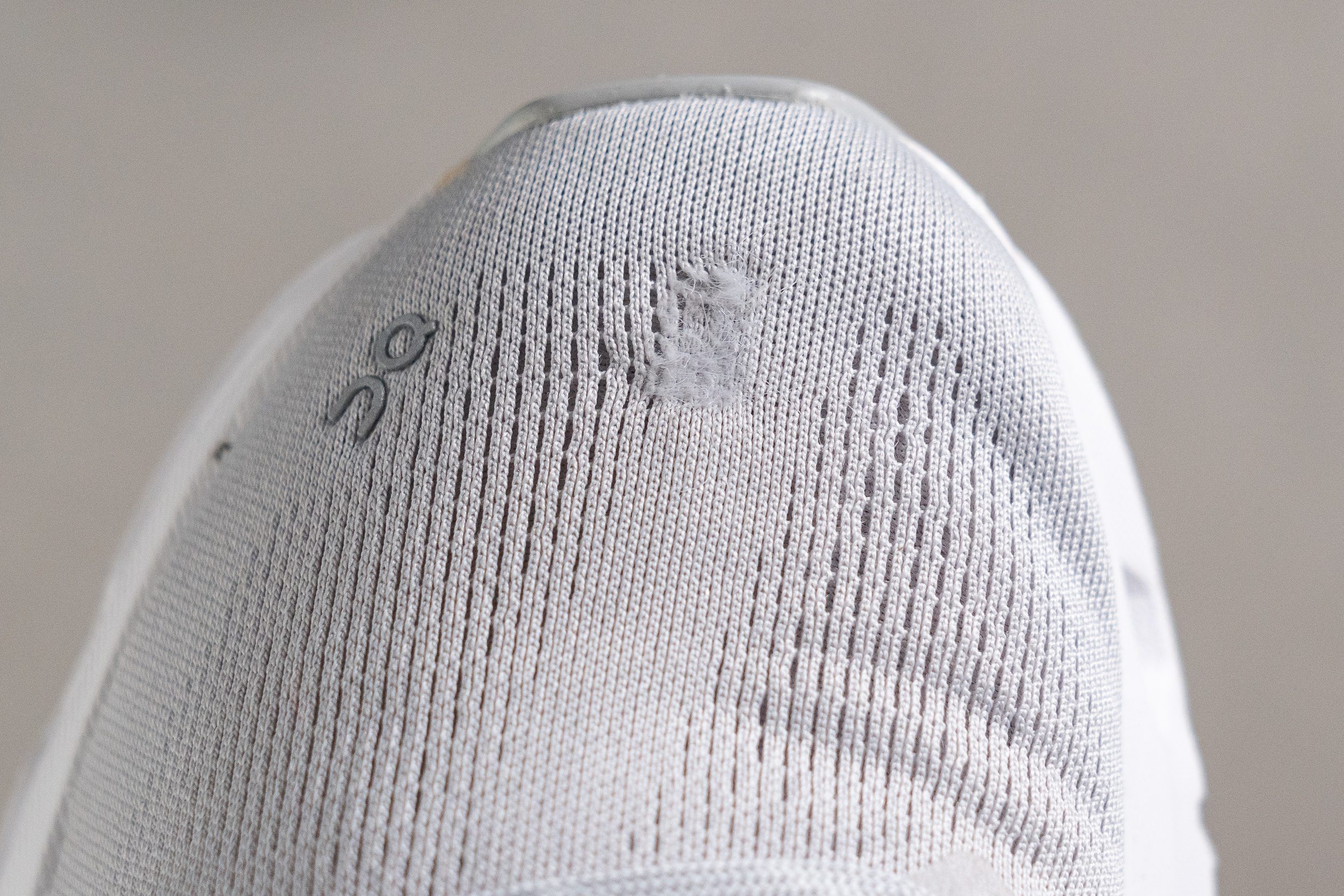
| Cloudflyer 5 | 4 |
| Media | 2.6 |
Durabilidad del acolchado del talón
Seguimos con el Dremel, pero ahora fuimos a por el acolchado del talón de las Cloudflyer 5.
Y, aunque es la versión número 5, parece que a este modelo le encanta el 4, ¡porque se ha llevado otro 4/5 en durabilidad!
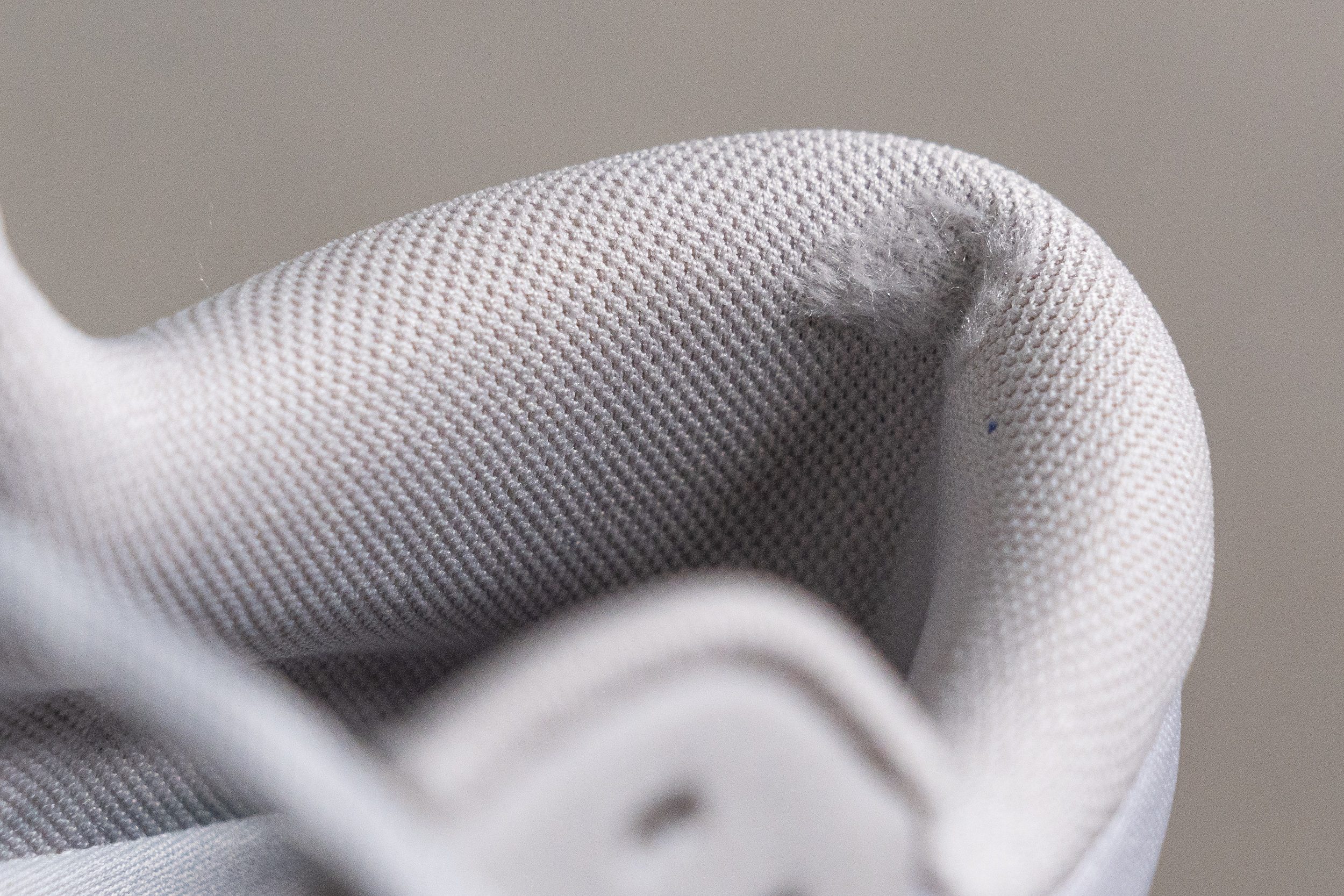
| Cloudflyer 5 | 4 |
| Media | 3.4 |
Dureza de la suela
Para evaluar la dureza del caucho de su suela exterior, presionamos nuestro durómetro contra ella, que marcó unos sólidos 83,3 HC.

Hemos visto que la suela exterior es muy parecida a la de las On Cloudmonster 2. Tiene piezas de caucho bastante grandes que cobren los lados del talón y la zona del antepié, mejorando la durabilidad. Además, cuenta con un corte central bastante grande que proporciona flexibilidad, aunque alguna piedrecilla pueda terminar ahí escondida de cuando en vez.

| Cloudflyer 5 | 83.3 HC |
| Media | 79.2 HC |
Durabilidad de la suela
Incluso en nuestra tercera prueba Dremel nos quedamos encantados con los resultados.
Con unos daños de solo 0,8 mm de profundidad, creemos que, aunque estas zapatillas son caras, su suela exterior ofrece un agarre y una resistencia al desgaste impresionantes.
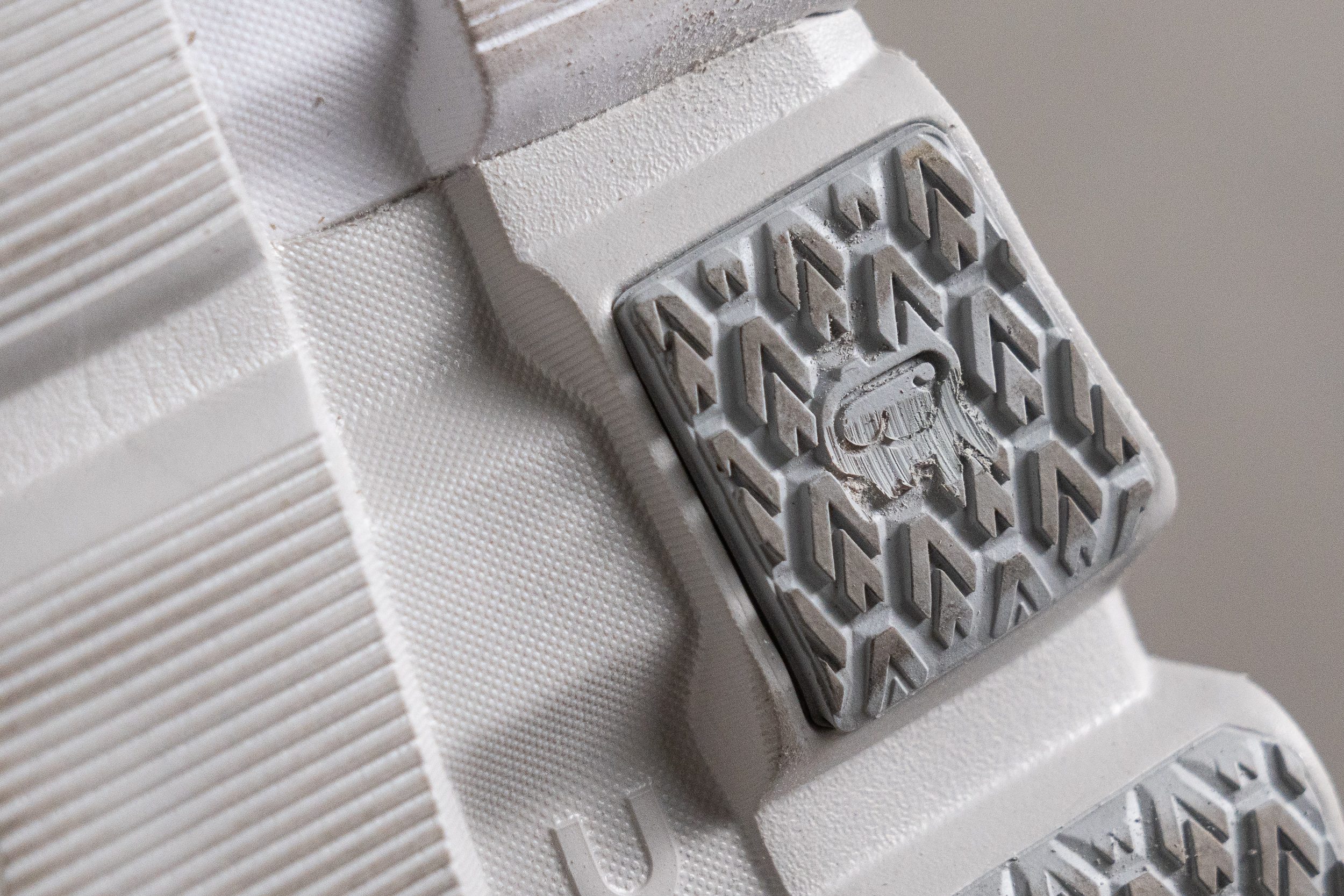
| Cloudflyer 5 | 0.8 mm |
| Media | 1.1 mm |
Grosor de la suela
Como conclusión al capítulo de la suela exterior, hemos decidido medir su grosor, y los 4,0 mm que marcó nuestro calibre nos parecieron demasiado.
Aunque las zapatillas de estabilidad suelen tener suelas exteriores más gruesas para soportar los patrones de desgaste de los corredores con pronación, creemos que 4,0 mm son demasiado para este modelo. Como el caucho es más grueso, también pesa más, y además crea una pisada bastante firme. Al ser un material tan resistente al desgaste, en nuestra opinión lo ideal habría sido un grosor más equilibrado, de 2,5 mm o 3,0 mm.
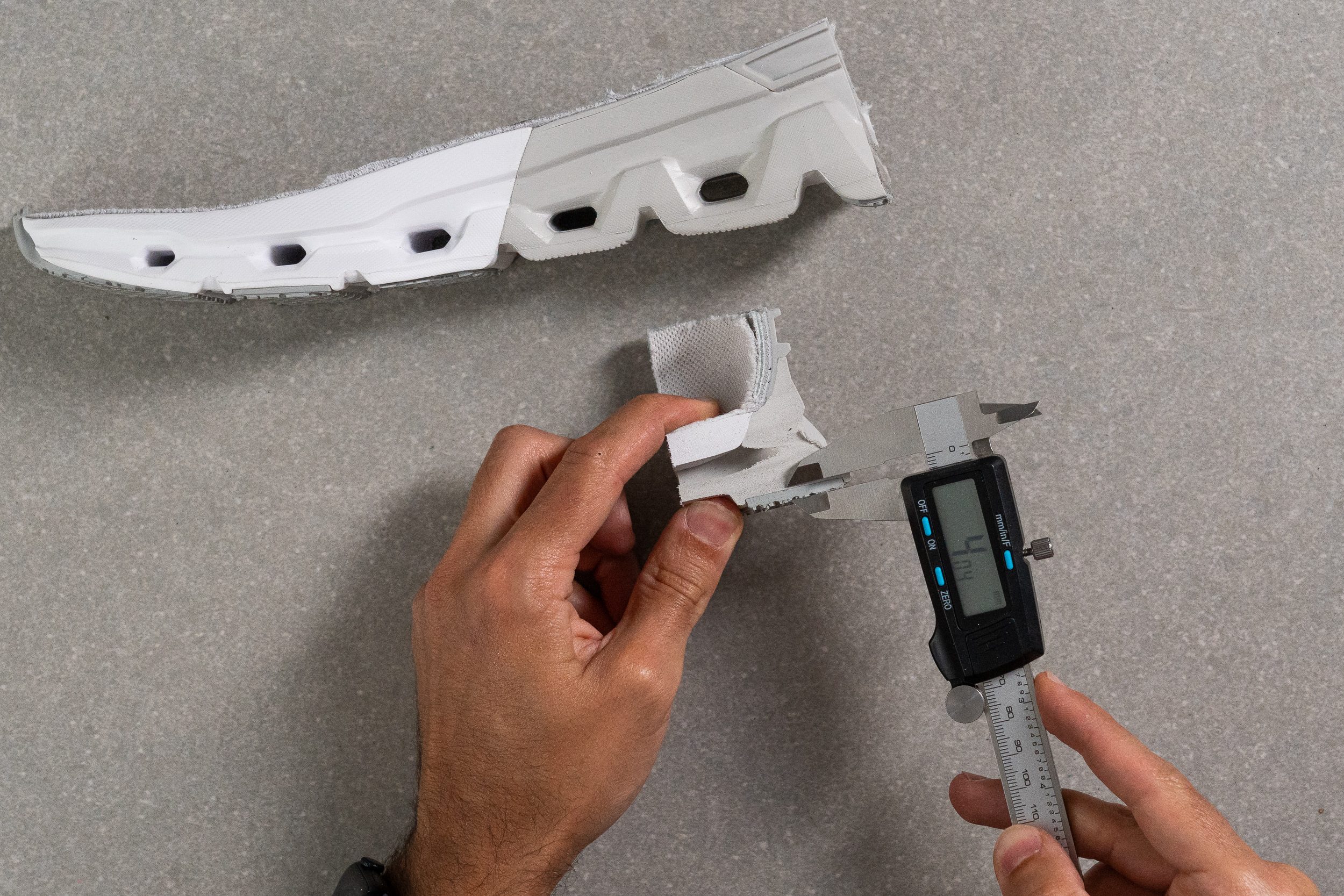
| Cloudflyer 5 | 4.0 mm |
| Media | 3.2 mm |
Varios
Grosor de la plantilla
La plantilla no es la típica de las zapatillas de running. Es un poco más premium, con una espuma de doble densidad que nos dejó totalmente boquiabiertos, ya que es muy poco común en las plantillas.
En el laboratorio, vimos que su grosor era de 4,8 mm, justo dentro del rango estándar.
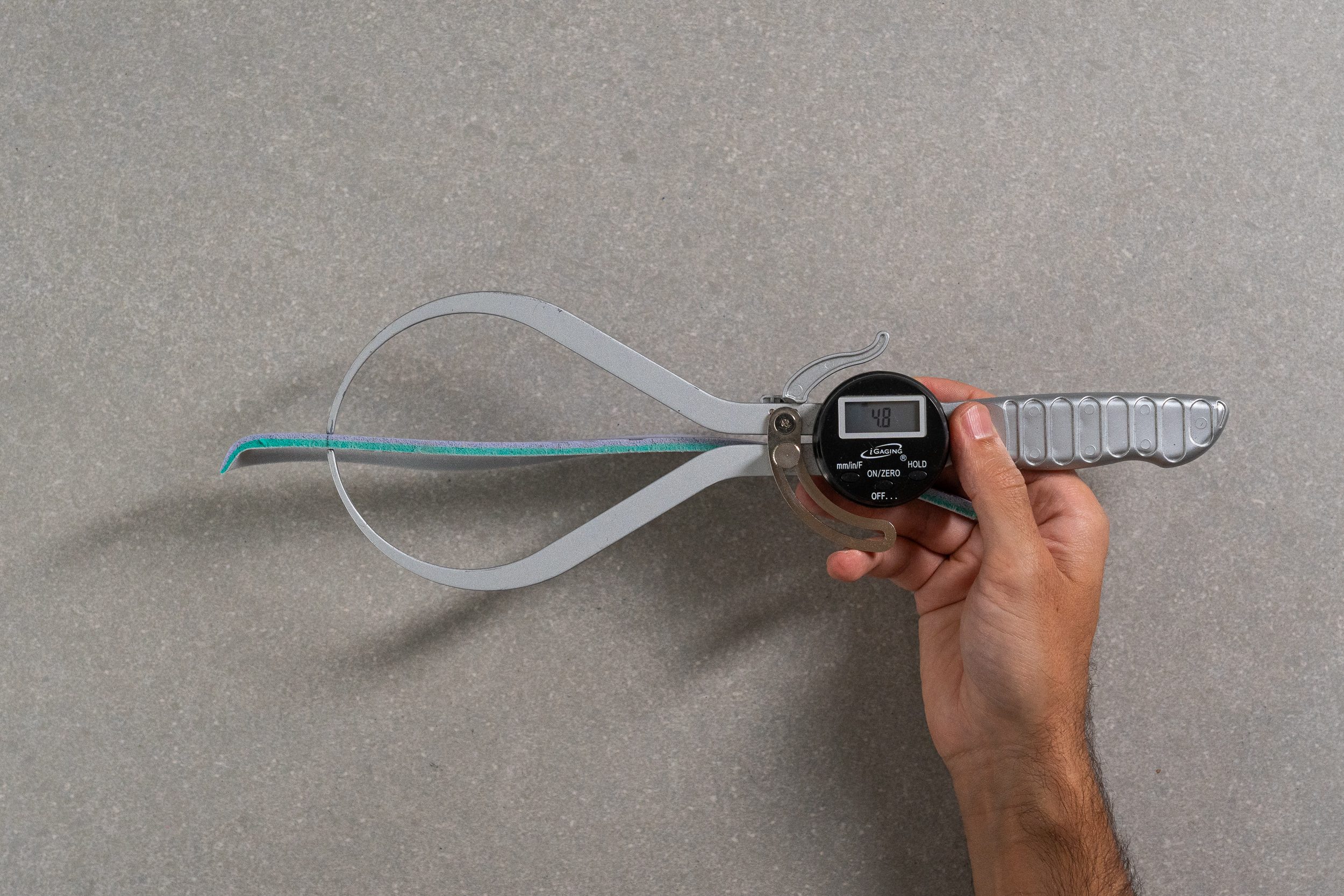
| Cloudflyer 5 | 4.8 mm |
| Media | 4.5 mm |
Plantilla extraíble
No tuvimos ningún problema al quitarles la plantilla, pero ten en cuenta que si la cambias te quedarás si el extra de estabilidad que el diseño de su talón les proporciona a los pies.
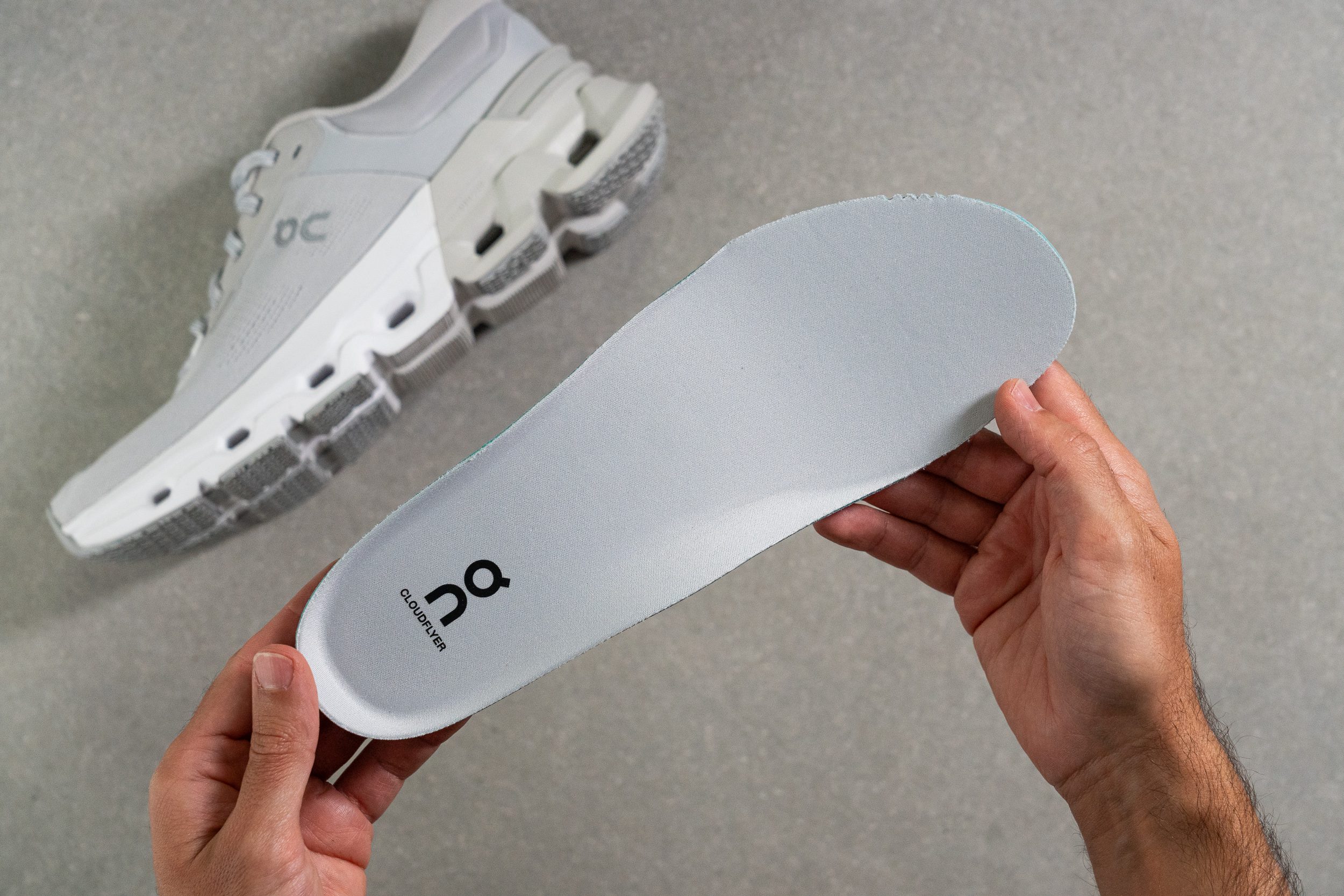
| Cloudflyer 5 | Sí |
Rigidez de la mediasuela en frío (%)
Descubrimos que a la espuma Helion no le molesta mucho el frío. A diferencia de la EVA estándar, que se puede volver demasiado firme a bajas temperaturas, la mezcla de EVA y OBC (copolímeros de bloque de olefina) de esta espuma se volvió un 32,1 % más firme después de estar 20 minutos en nuestro congelador. Aunque no es un resultado increíble, no deja de ser mejor que el de la mayoría de las EVA simples.
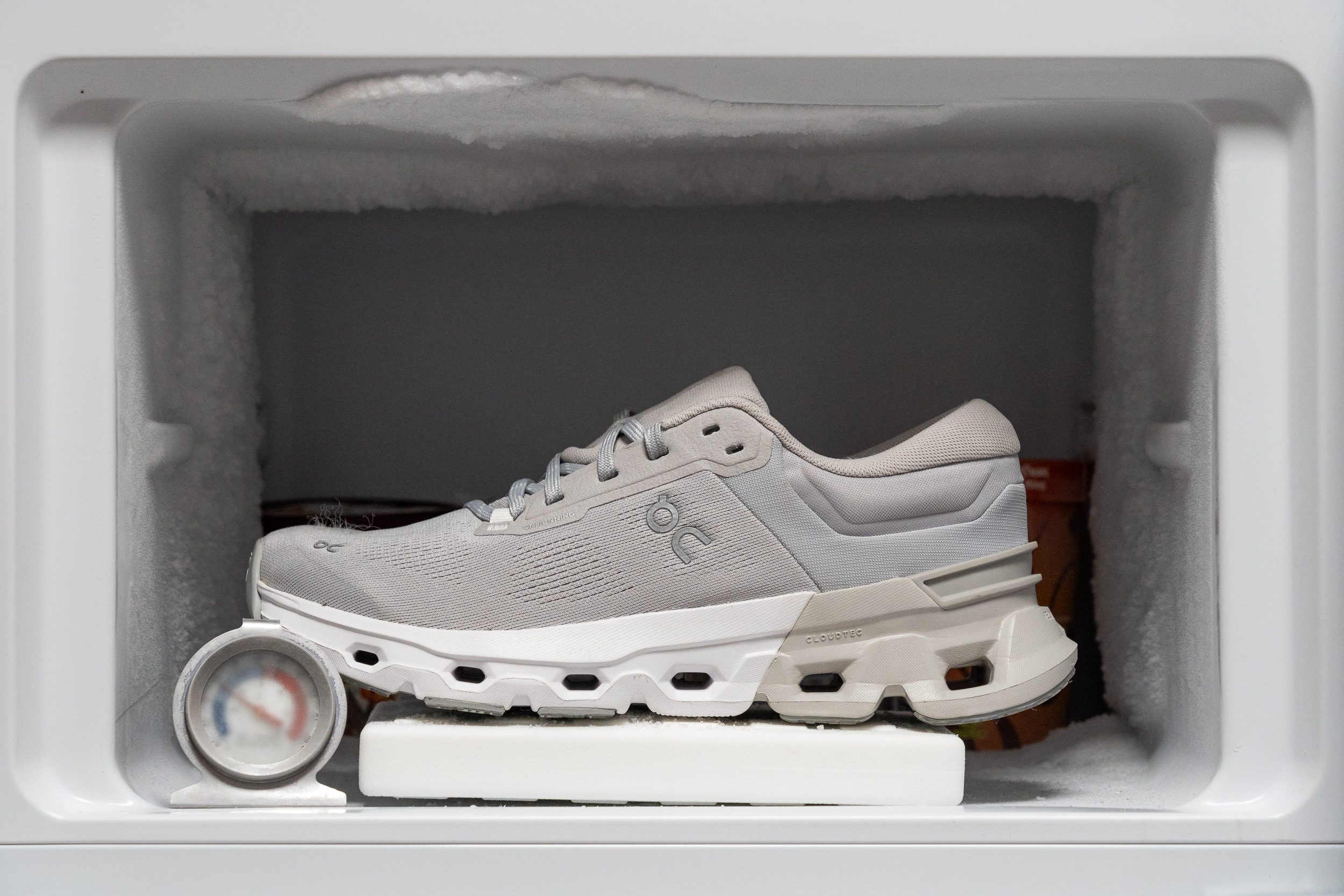
| Cloudflyer 5 | 32% |
| Media | 24% |
Elementos reflectantes
Estamos encantados de poder decirte que las Cloudflyer 5 tienen elementos reflectantes. La parte que se ilumina es el logo de On, un detalle que nos parece chulísimo, y son los toquecitos de este estilo los que buscamos en nuestro laboratorio cuando analizamos y dividimos en partes unas zapatillas de precio premium.
| Cloudflyer 5 | Sí |
Acolchado de la lengüeta
La lengüeta de 9,9 mm nos deja claro que On se preocupa por la comodidad. Tiene un diseño de triple capa con una pieza de espuma muy blandita en el medio, ¡seguro que tu empeine estará encantado!
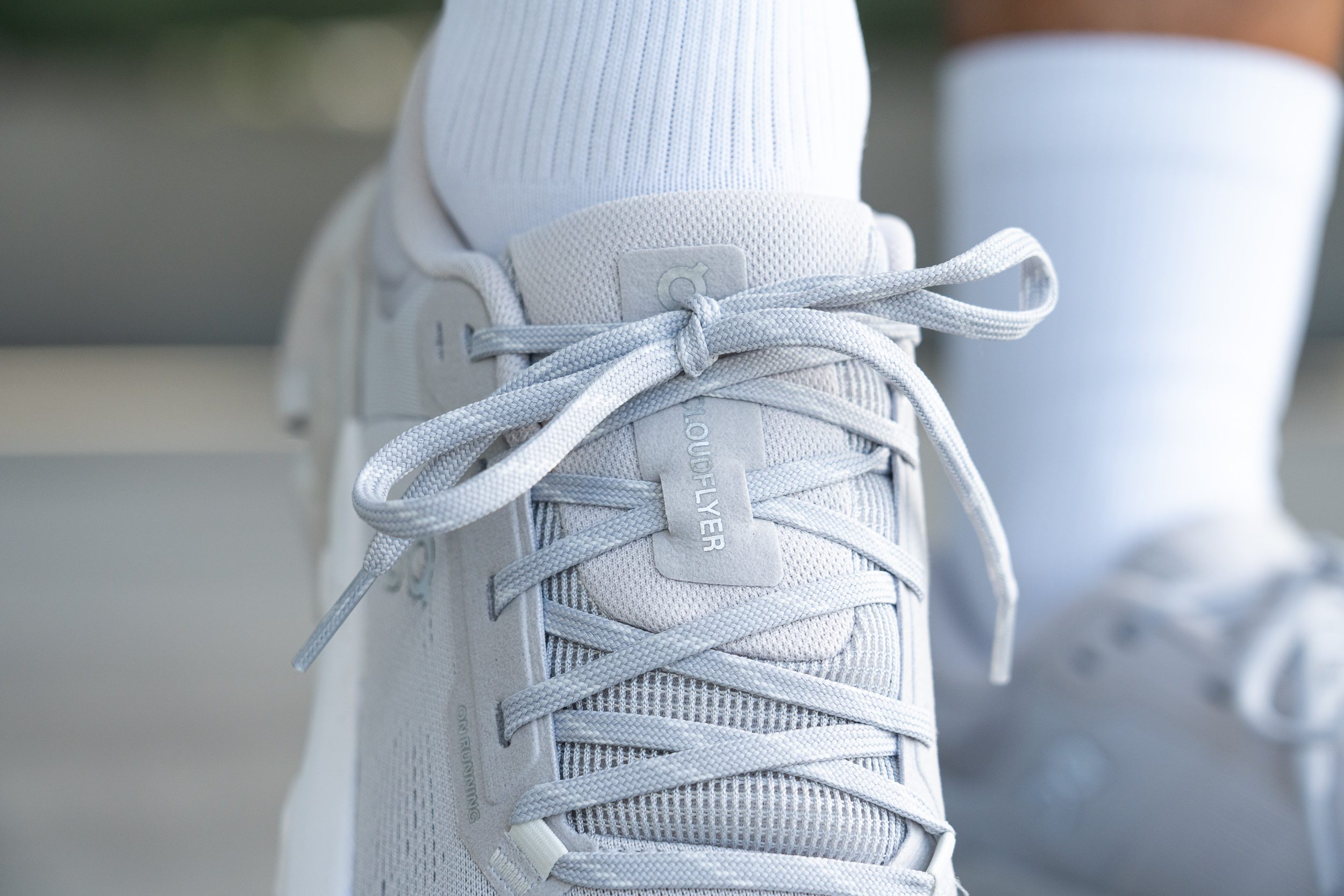
En nuestra opinión, los cordones le dan el toque final perfecto a este diseño de alta calidad. Son planos y duraderos, y no tienen problema al meterse por los ojales perforados, así que se están quietos. La única excepción es el primer ojal, que en vez de ser un agujero es un lazo. La verdad es que creemos que la marca podría haberlo omitido, nos parece que es un poco para hacer el paripé, la verdad.
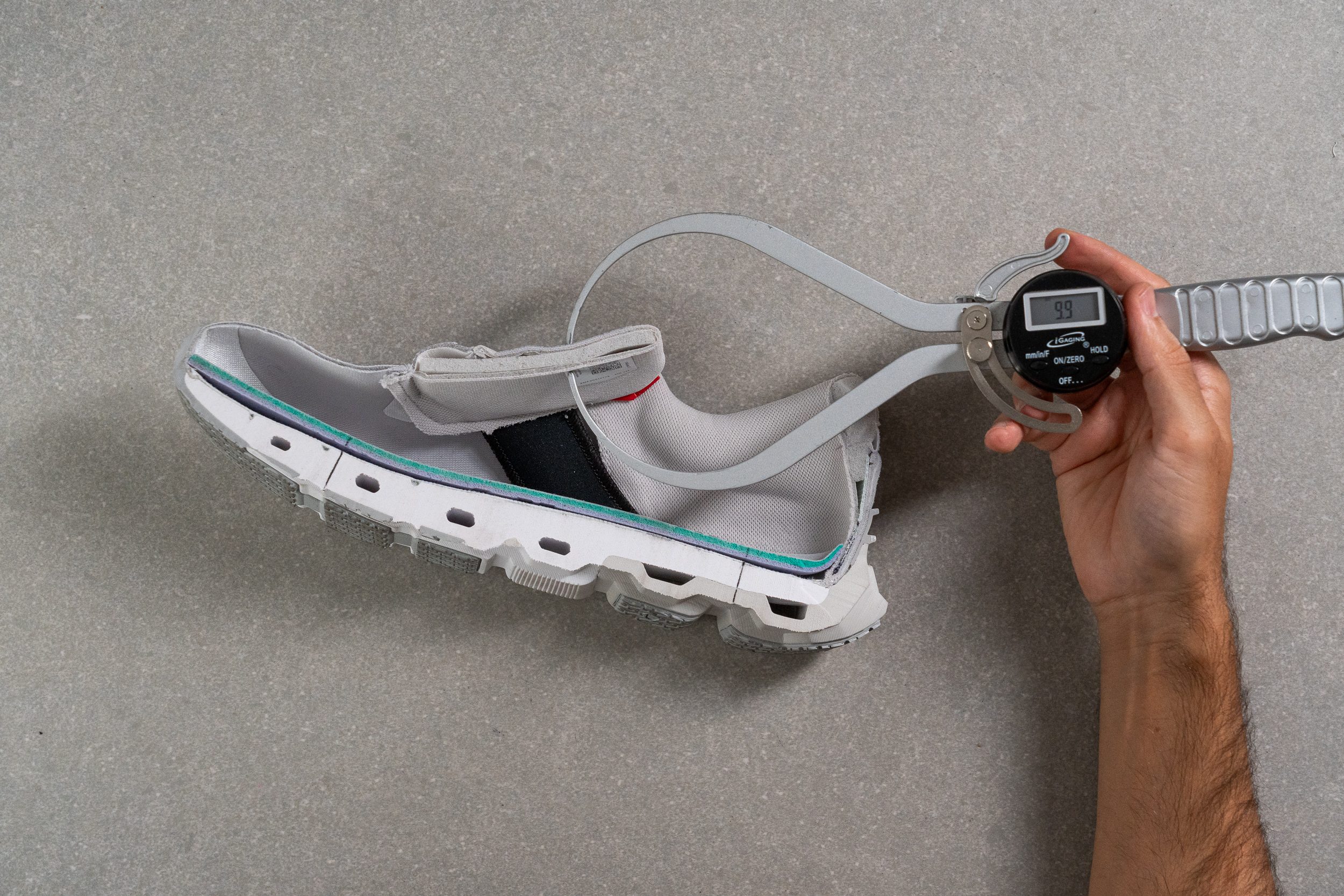
| Cloudflyer 5 | 9.9 mm |
| Media | 5.8 mm |
Lengüeta: tipo de refuerzo
Nos quedamos encantados al ver que la lengüeta de este modelo está tan bien sujeta a los laterales, además de que no nos estrujó los pies. Tiene un cachito de tela elástico que la agarra a la mediasuela, manteniéndola perfectamente en su sitio mientras corres. Para nosotros es un diseño impecable, ¡y ojalá más modelos de running lo tuviesen!

| Cloudflyer 5 | Ambos lados (semi) |
Precio
Como ocurre con la mayoría de las zapatillas de running de On, su precio es un poco más elevado que el de muchas otras marcas, lo que deja la elección en manos del cliente.
¿Que si creemos que estas zapatillas se merecen el precio que tienen? Pues, a ver, si nos basamos en la sensación y calidad que proporcionan, entonces probablemente sí. Pero hemos tenido experiencias de carrera mejores con opciones más asequibles, así que no podemos evitar tener ciertas dudas.
| Cloudflyer 5 | $170 |
Tirador del talón
El diseño del talón es estándar. On suele incluir tiradores en sus zapatillas de trail, pero hay veces que prefiere ir a por algo más elegante y pasa de ponérselos a sus modelos para correr por carretera. Aunque, personalmente, a nosotros nos encantan los tiradores, esta elección de diseño tan impecable también nos parece genial.
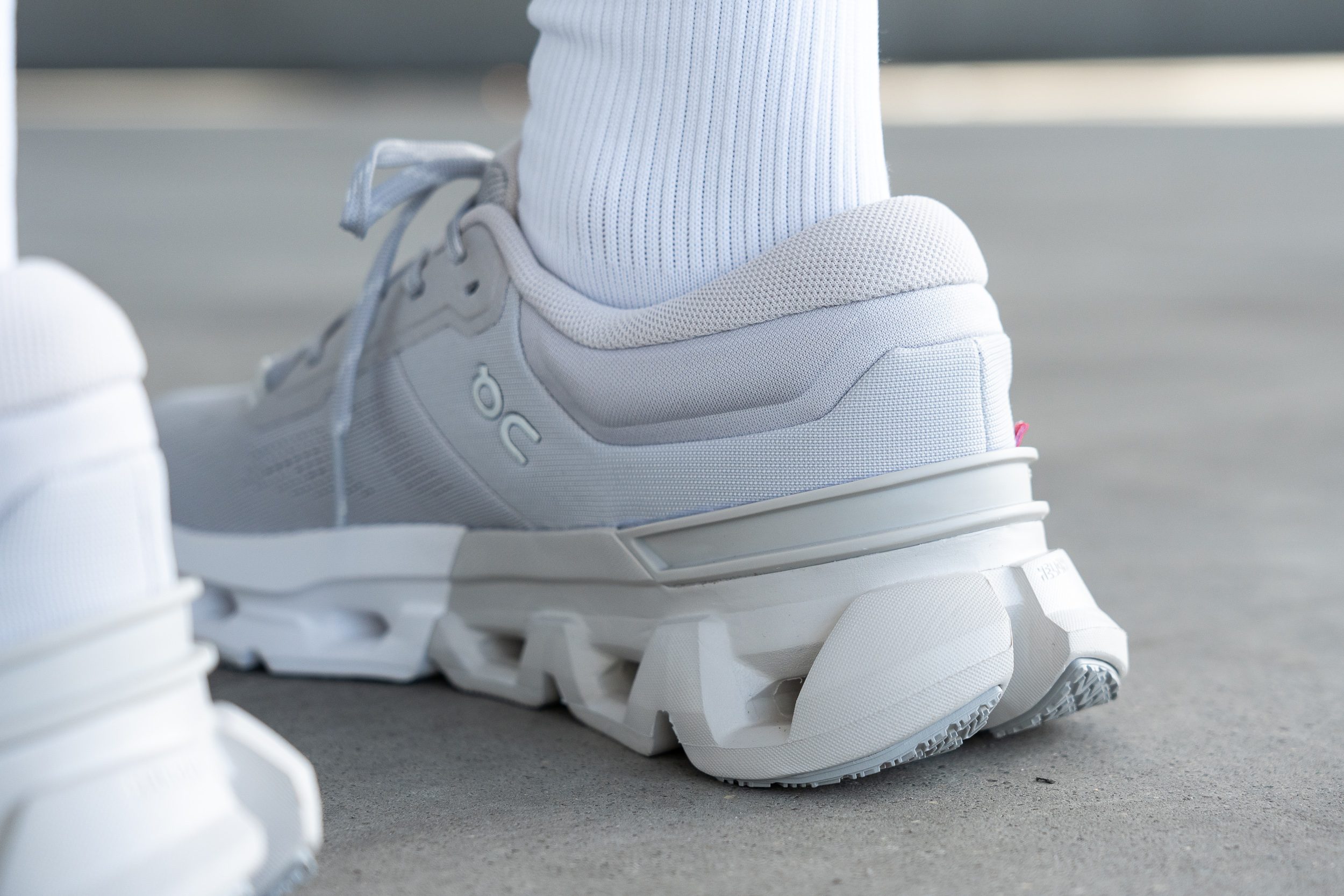
| Cloudflyer 5 | Ninguno |



























































